I Tested Every SciSpace Alternative. Only 5 Didn’t Suck

SciSpace is genuinely useful. Its Literature Review feature is one of the best I’ve ever seen. The AI-powered dynamic table creation is remarkable.
Based on my testing, only Elicit comes close to that feature. The AI Writer and Chat With PDF features work as intended.
SciSpace even has a 4.4-star rating on Capterra based on 61 user reviews.
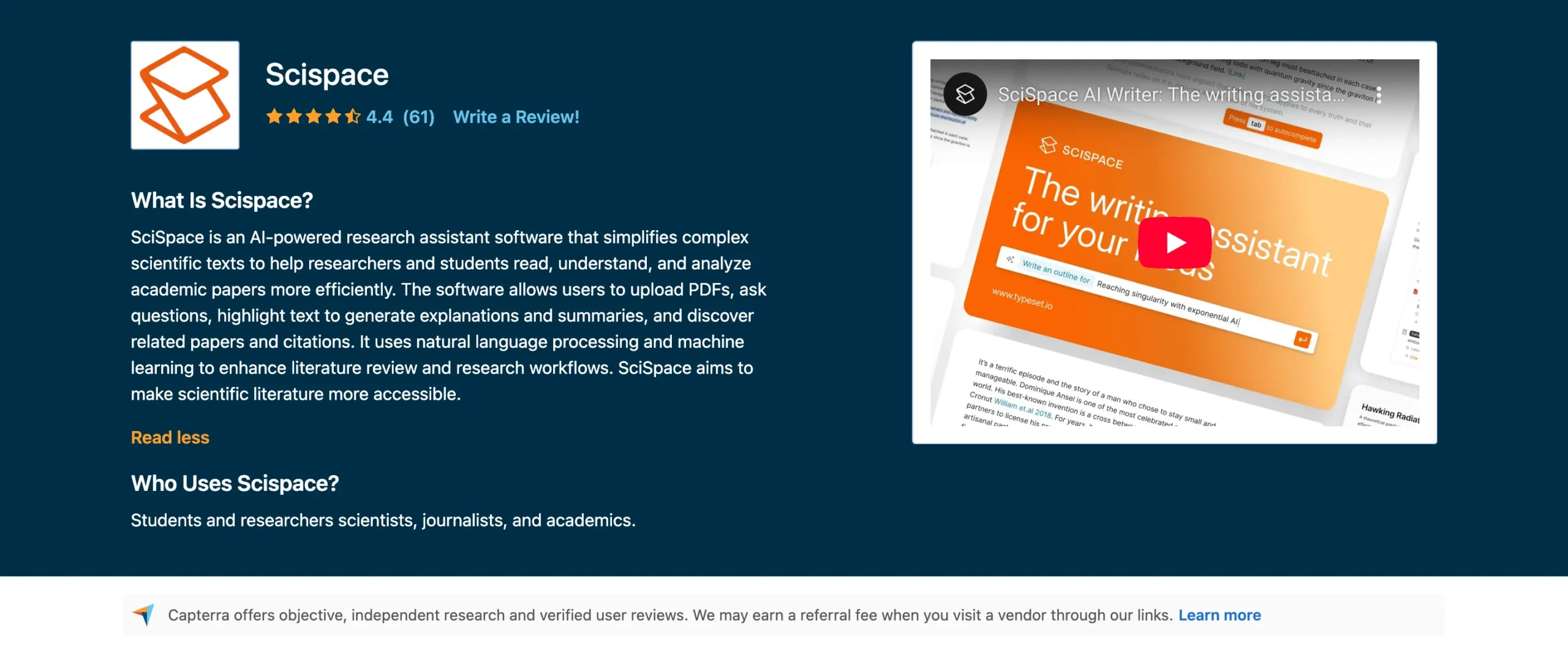
Yet, researchers are fleeing.
How do I know?
According to Semrush, at least 180 people worldwide search for “SciSpace alternative” every month. (Search volume is almost always higher than reported.)
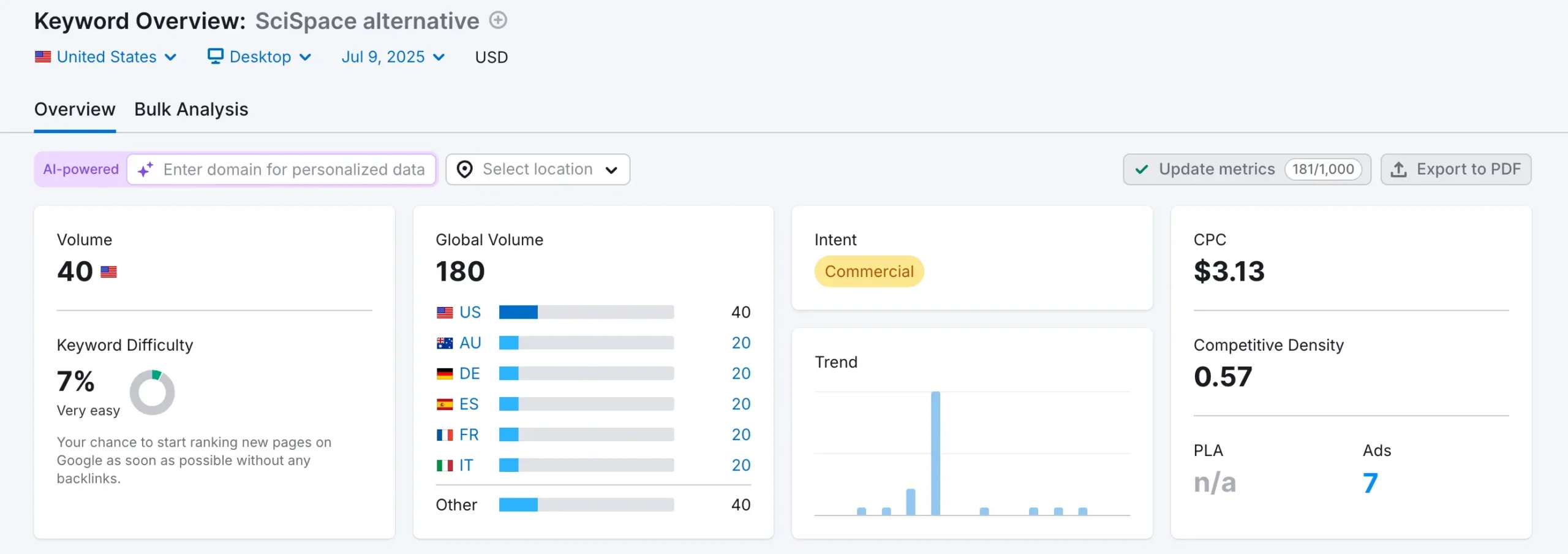
Even more interesting: this keyword has a $3.13 cost-per-click, meaning SciSpace’s competitors are bidding against each other to reach these escapees.
This made me curious.
What if there are tools that do everything SciSpace does but better and/or cheaper?
That question led me to the five alternatives this article uncovers.
Best for complete academic toolkit

Paperpal
Perfect for: Researchers needing research and writing in one tool
Pricing: $139 per year ($25 monthly)
All-in-one: AI writer, 10K+ citation styles, plagiarism checker, grammar fixes. Trained on 250M+ papers. Everything SciSpace has plus more.
Best for seamless academic writing

Jenni AI
Perfect for: Writers who want AI assistance without disrupting workflow
Pricing: $144 per year ($30 monthly)
Cleanest writing interface. Auto-completes paragraphs, adds citations automatically. Imports Zotero/Mendeley libraries.
Best for paper discovery only

Semantic Scholar
Perfect for: Researchers who need to find and understand papers quickly
Pricing: Free forever
Free research discovery. TLDRs give 20-word paper summaries instead of long abstracts. AI feeds recommend papers. Zero writing features—discovery only.
What are the best SciSpace alternatives?
The 5 Best SciSpace Alternatives at a glance
TOOL | BEST FOR | STANDOUT FEATURE | PRICING |
|---|---|---|---|
Paperpal | Everyone who wants one tool that works | The only complete package: writing, citations, grammar, plagiarism checking. Does everything SciSpace does, plus what it doesn’t. | $139/year ($25 monthly) |
Jenni AI | Writers who want AI that doesn’t take over | Beautifully invisible interface. But zero research features—you’ll still need another tool for finding papers. | $144/year ($30 monthly) |
Semantic Scholar | Researchers who only need to find papers | TLDRs save hours of abstract-skimming. But can’t write, cite, or check anything—purely discovery. | Free |
Elicit | People who loved SciSpace’s tables | Clean interface, better workflow. But still no writing features—it’s SciSpace with better design, not more capability. | $120/year ($12 monthly) |
Consensus | People with one specific research question | Shows what % of papers agree/disagree on your question. Filters 1,000+ papers down to 50 that matter. | $108/year ($11.99 monthly) |
#1 — Paperpal
Available on: the web, MS Word, Google Docs, and Overleaf (Chrome extension).
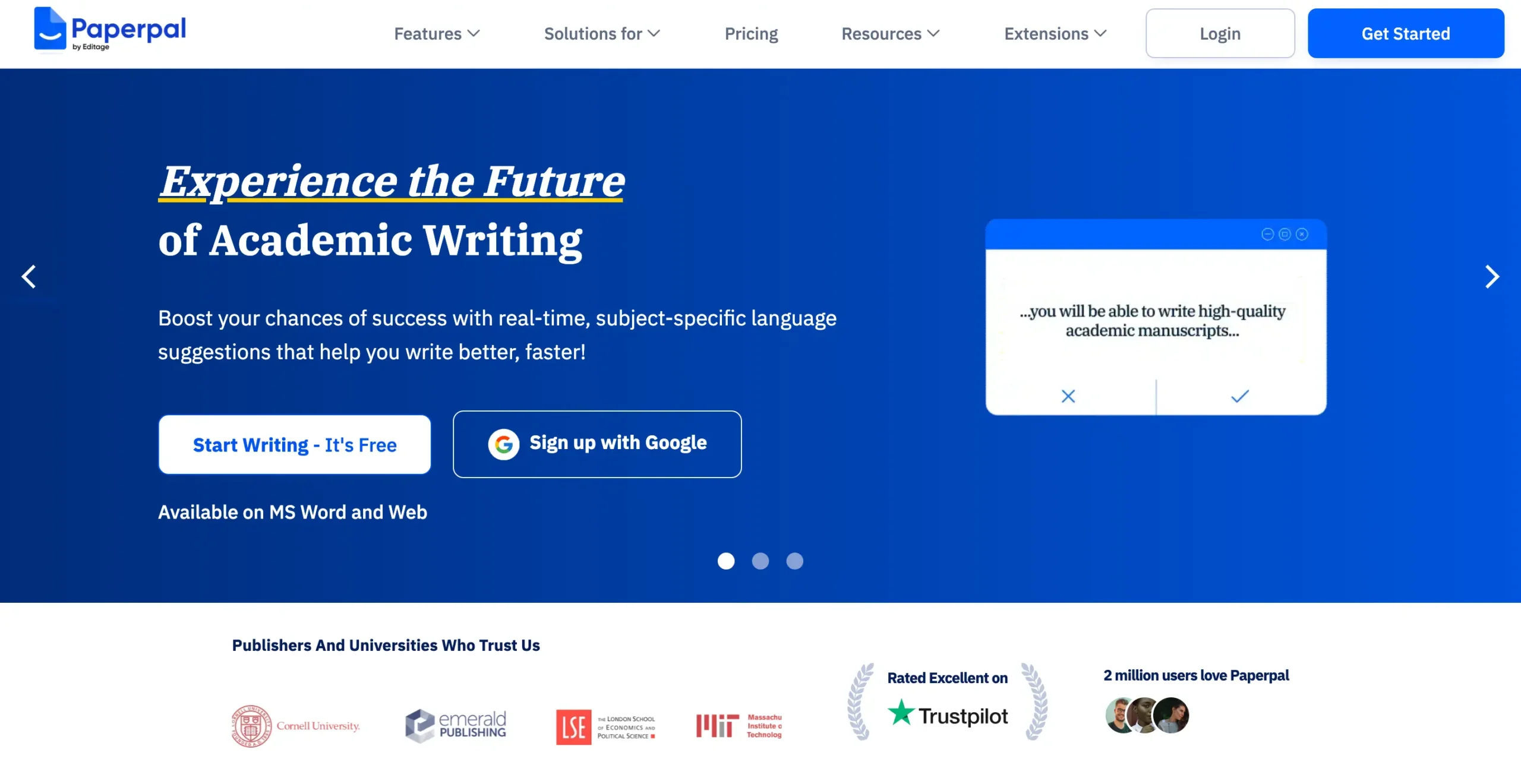
Pros
Cons
Paperpal is my top SciSpace alternative. It works as both an AI research assistant and an academic writing tool.
Paperpal has nearly every feature SciSpace offers: AI writer, paraphraser, citation generator, literature review, chat with PDF.
But it adds what SciSpace lacks entirely—an AI-powered grammar and language checker, among other things.
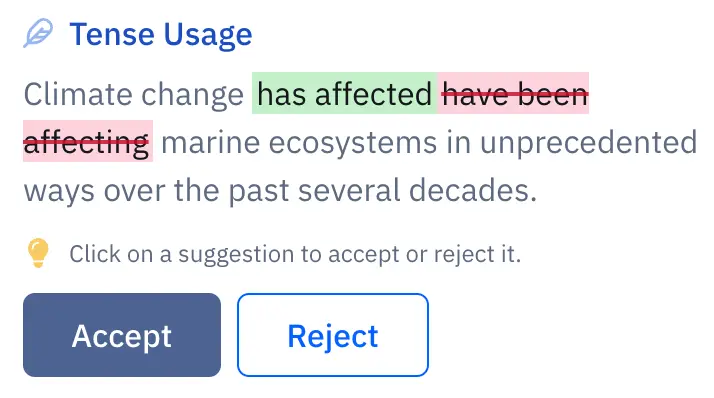
SIDENOTE: Read my definitive Paperpal vs Grammarly comparison guide to learn more about Paperpal’s grammar-checking capabilities.
Trained on 250+ million research papers with 22+ years of academic publishing experience, supporting 10,000+ citation styles across 30+ languages, Paperpal isn’t another AI wrapper chasing trends.
It’s a company with a solid foundation and a clear vision.
The interface is clean: collapsible left and right sidebars with a central writing panel.
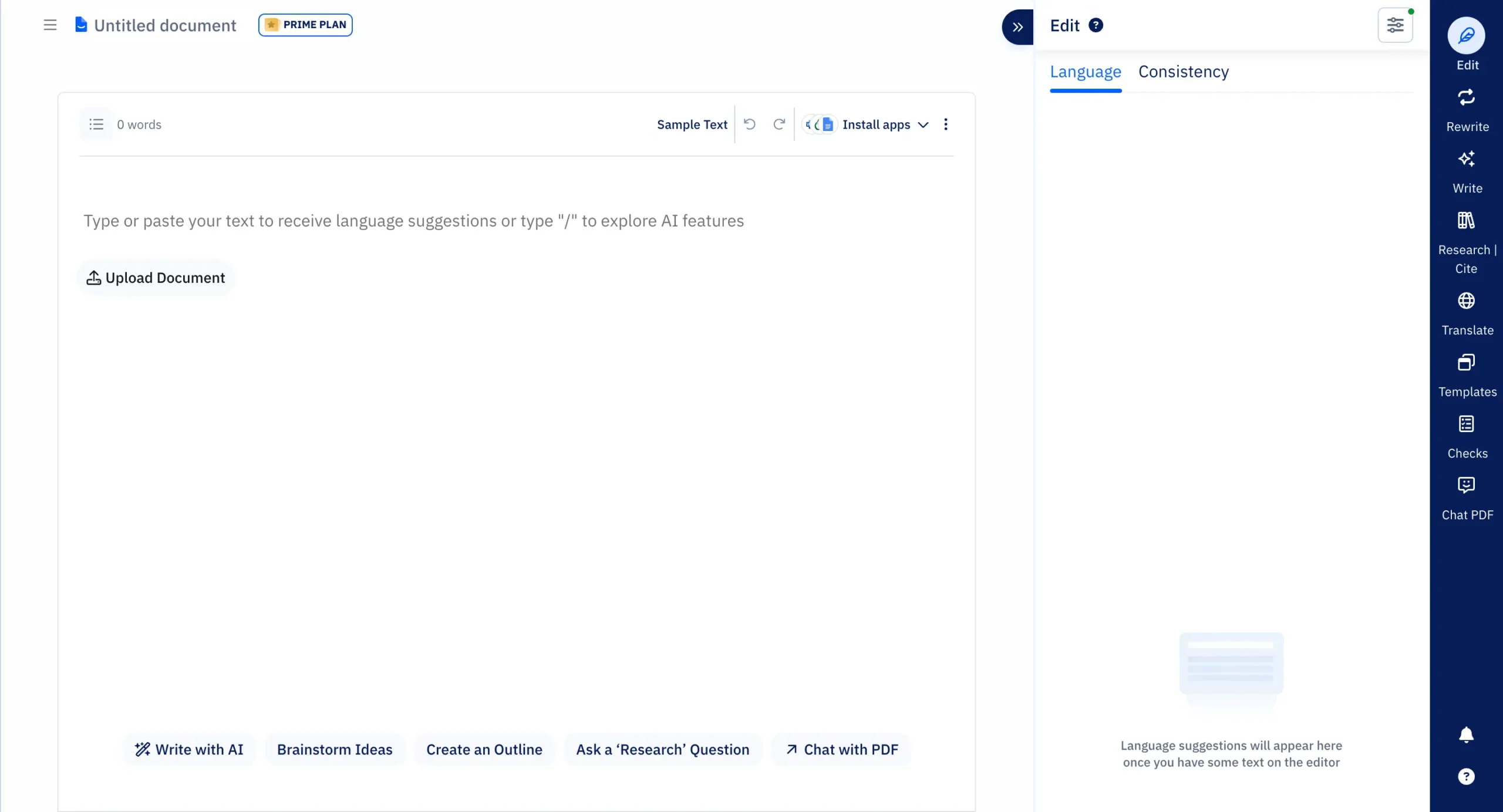
Here are four ways to use Paperpal effectively:
1. Start from scratch: Begin writing in the AI interface. Press ‘/’ for formatting or AI help—all options appear instantly.
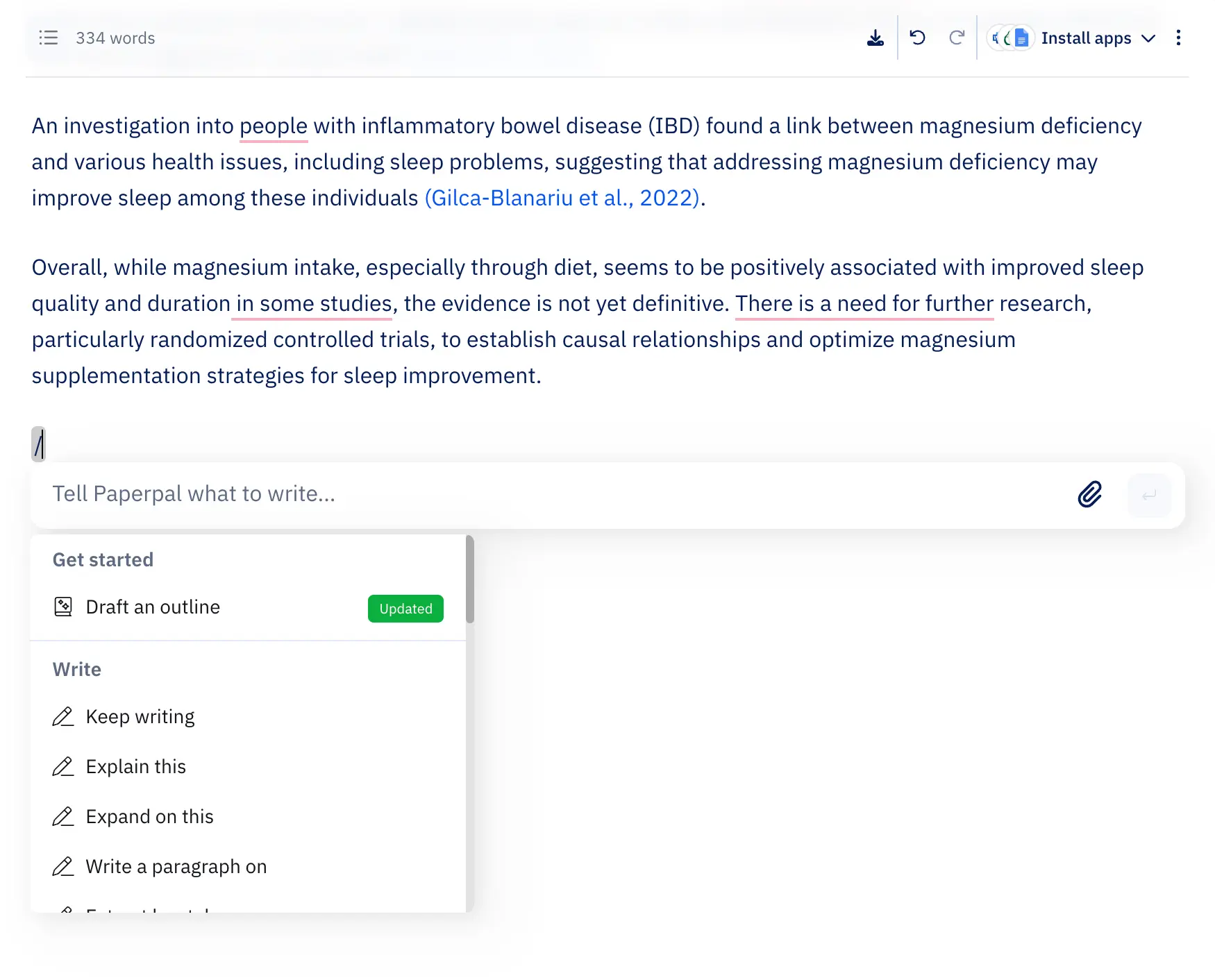
2. Start with Research | Cite: This is Paperpal’s best feature. Ask any academic question in the “ASK A QUESTION” container.
Paperpal searches 150M+ journal articles, 40M+ Open Access papers, 10M+ conference papers, and 3M+ preprints (with 5,000+ new papers added daily).
You get the reference-backed output you can trust.
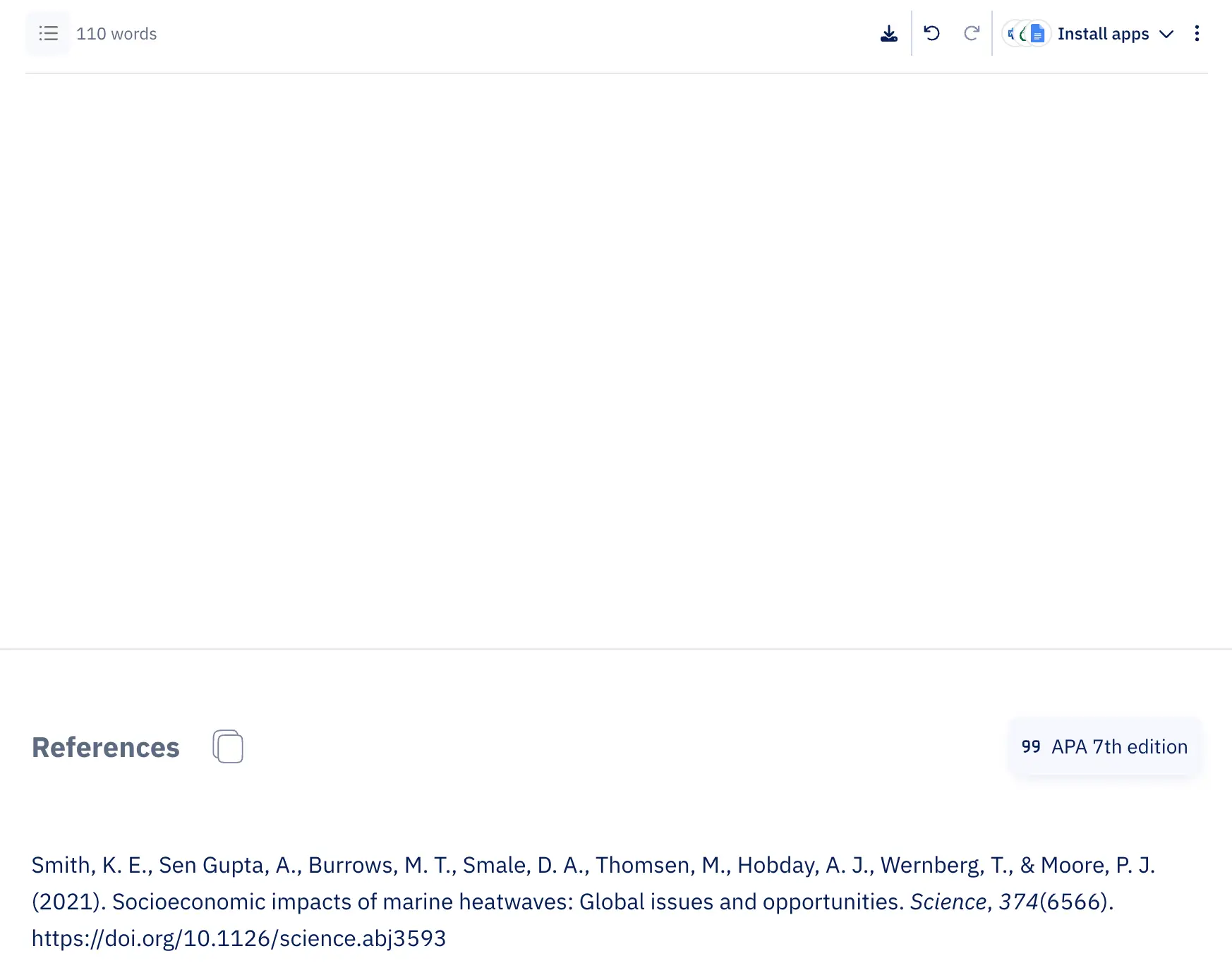
Search papers by keyword, title, or DOI.

Choose from 10,000+ citation styles.
3. Start with templates: Paperpal offers templates for research paper outlines, topic brainstorming, title generation, abstracts, summaries and more.

4. Use the Write feature: A simple chatbot in the right sidebar that knows everything you’ve written so far.
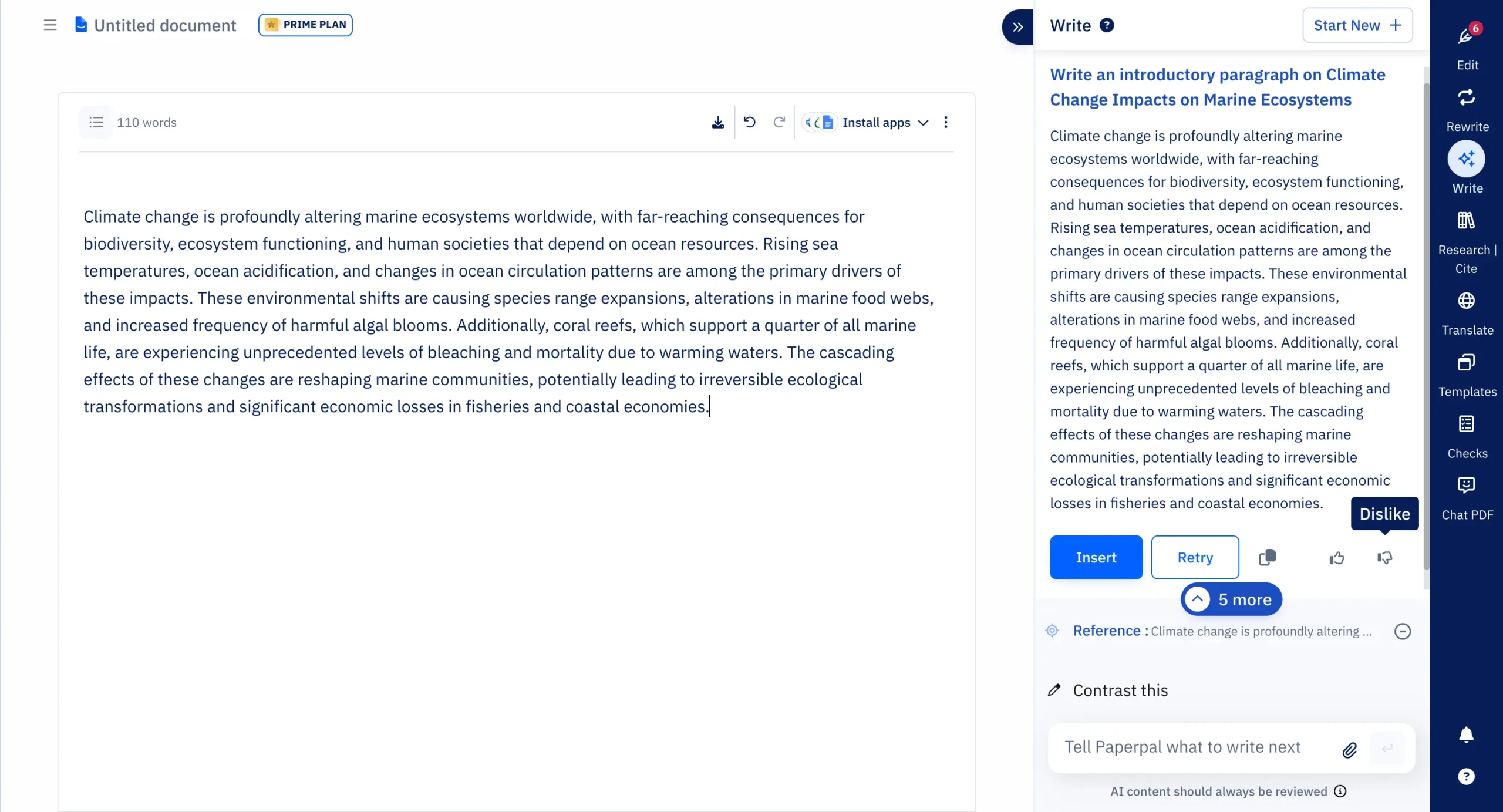
CAUTION: Unlike ‘Research | Cite,’ the ‘Write’ feature doesn’t provide sources. Fact-check everything before trusting it.
Paperpal recently fixed this problem beautifully.
After generating content with ‘Write’, select the paragraph and click ‘Cite.’ Paperpal searches millions of papers and automatically suggests relevant citations.
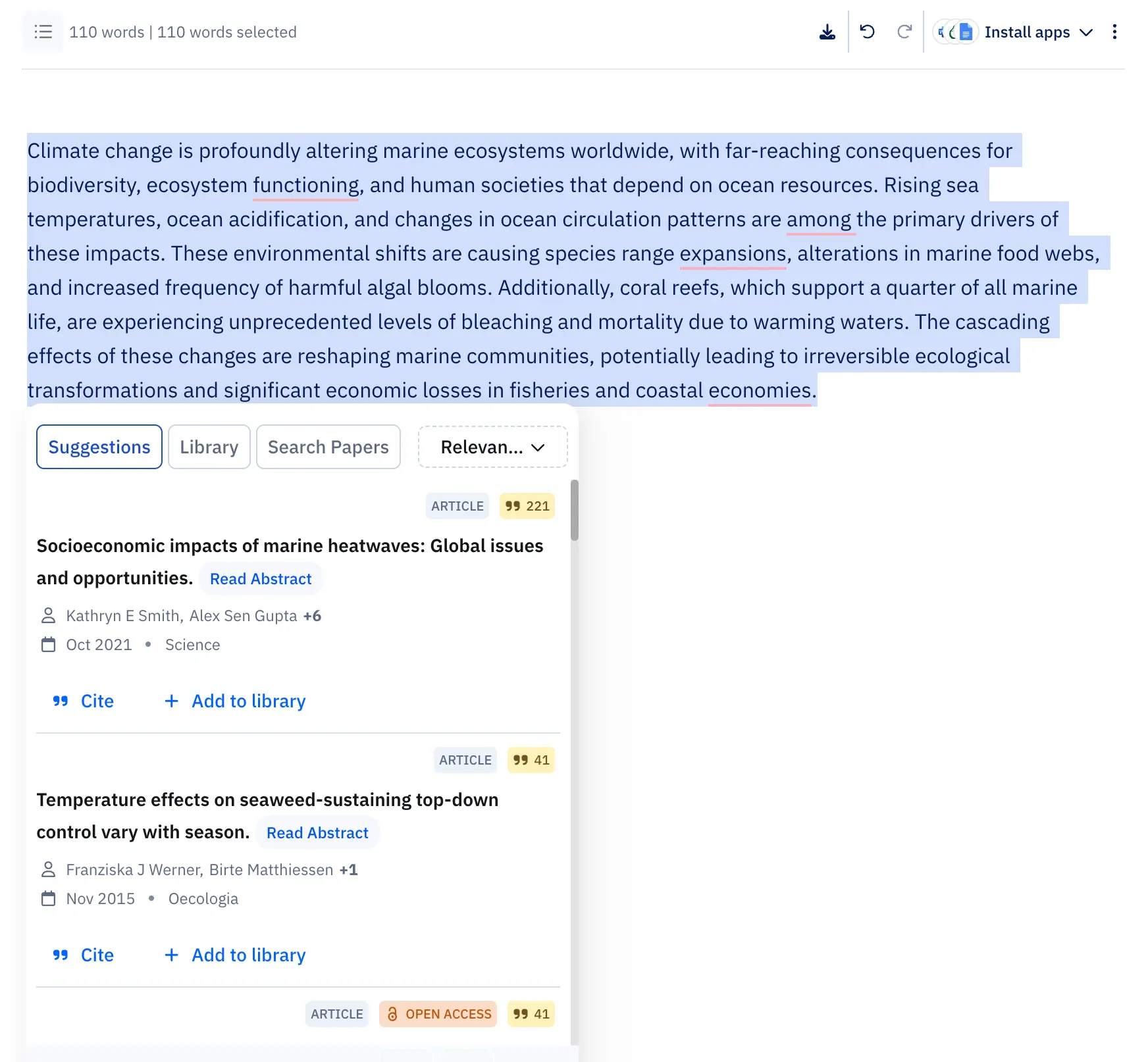
Paperpal’s interface looks professional compared to SciSpace’s “AI Writer,” which resembles a nicely copied Google Docs.
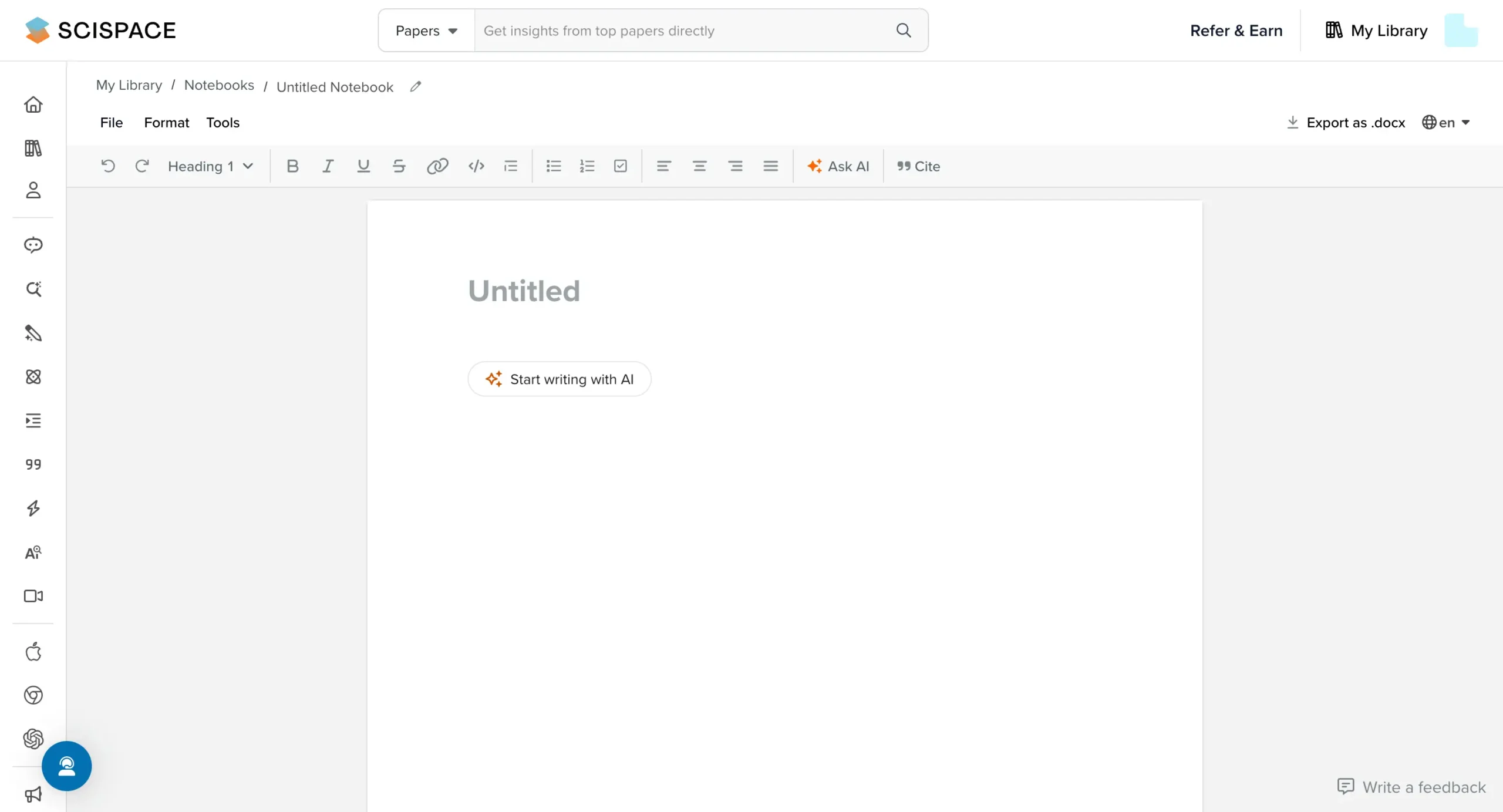
While SciSpace has an Academic AI Detector but misses plagiarism checking (more important in academia), Paperpal offers three finishing checks:
- AI Review: Reviews your text for language, readability, flow, and logical gaps
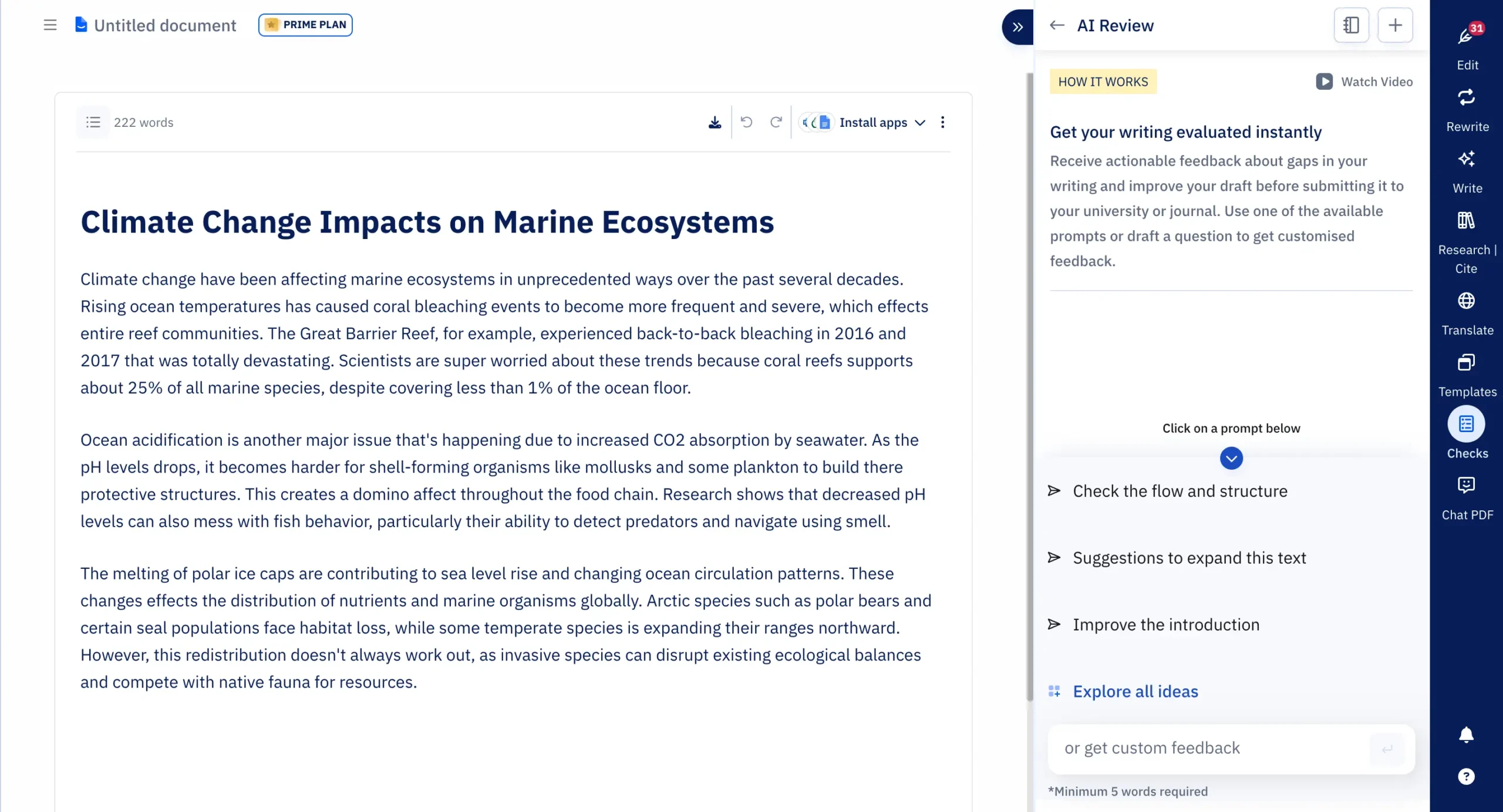
- Plagiarism Check: Detailed similarity analysis for potential plagiarism

- Journal Submission Check: Language edits and technical checks to improve journal acceptance odds

Paperpal is nearly complete. My only major complaint is the 10,000/month plagiarism checking cap for Prime members.
While equally good or better options may exist for literature reviews and academic searches, Paperpal leads in AI academic writing.
For everything about Paperpal—what it is, does, and doesn’t do—read my complete Paperpal review.
Paperpal pricing
SciSpace uses decoy pricing: Basic ($0), Premium ($12-20/month), and Advanced ($70-90/month). The expensive tier exists to make the middle option feel reasonable.
Paperpal offers two simple choices: Free or Prime ($25/month, $55/quarter, and $139/year).
Paperpal Prime ($139/year) includes everything SciSpace Advanced offers—unlimited writing features, advanced AI, plus 10,000 words of plagiarism checking monthly.
The discount changes everything: Use my discount code DZ30 and get 30% off your first payment on any Paperpal Prime plan—monthly, quarterly, or annual.
#2 — Jenni AI
Available on: web.

Jenni AI pros
Jenni AI cons
Jenni AI is an academic writing co-pilot that’s always there when you need it and hidden when you don’t.
This is what I really like about Jenni AI—just like the best tools should be, you almost forget you’re using it while you’re using it. It’s that seamless and well-integrated with your writing workflow.
Unlike SciSpace or Paperpal, Jenni AI doesn’t offer a lot of tools.
In fact, it does one thing and does it exceptionally well: academic writing.
Jenni has divided its core offering into two main use cases: reading research and writing research.
But here’s what sets Jenni apart from every other alternative: it doesn’t force you to abandon your existing research workflow.
Most AI academic tools treat your years of collected research like it doesn’t exist. Jenni does the opposite—it imports your entire research library from Zotero and Mendeley in seconds.
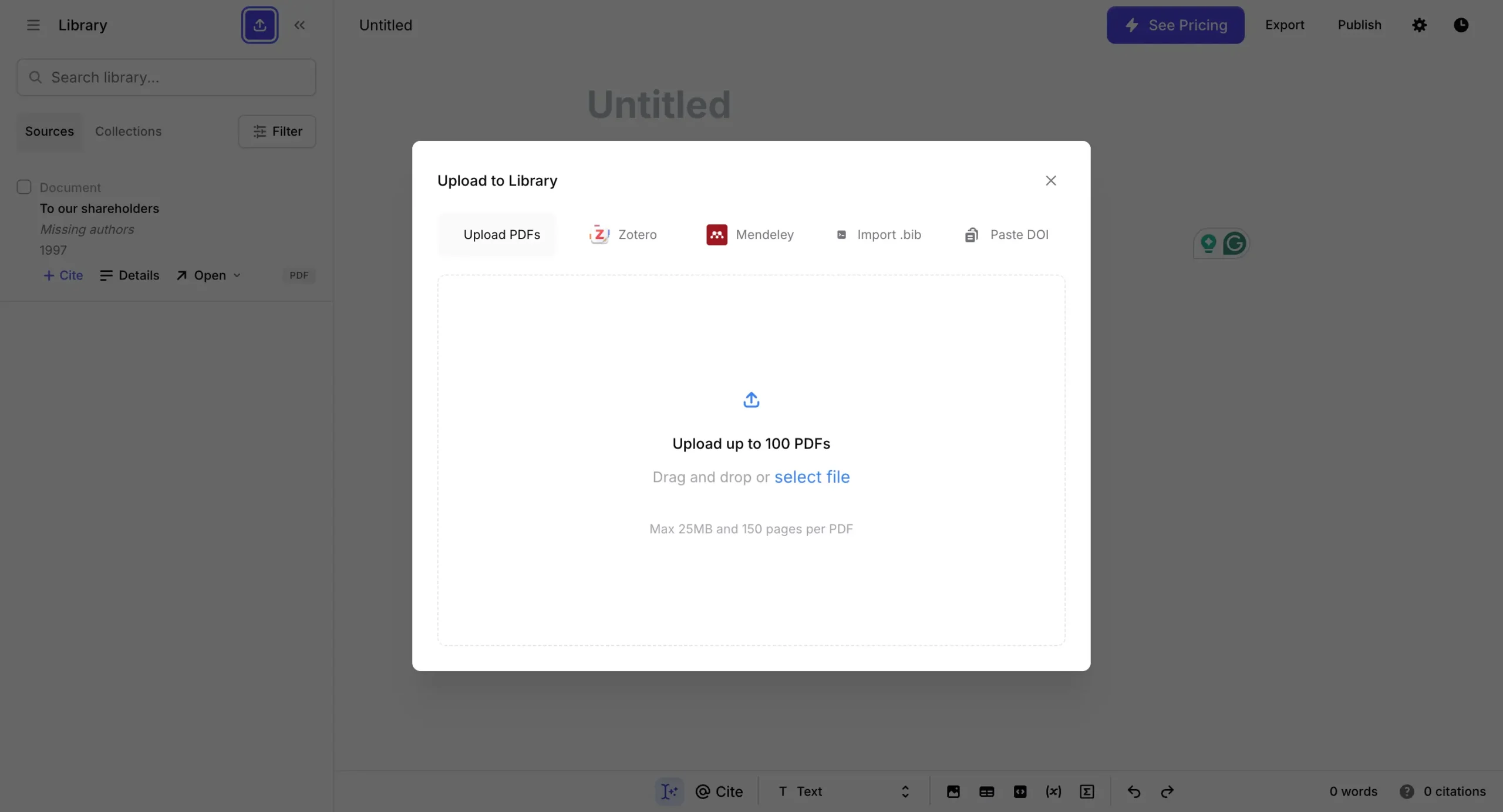
For reading research, Jenni AI has an “Upload PDF” feature.

You upload PDFs to Jenni’s library and open them in a built-in PDF reader.
There, you can read the PDF while interacting with the document using their AI Chat.

SIDENOTE: The free plan allows 10 PDF uploads and 10 AI chat messages per month.
However, Jenni’s PDF reader isn’t ideal. Unlike Paperpal and SciSpace, you can’t highlight specific text and use AI on that selection.
There aren’t even basic highlighting, note-taking, and annotation features.
For writing research, Jenni has an AI-powered document capability (their best feature).
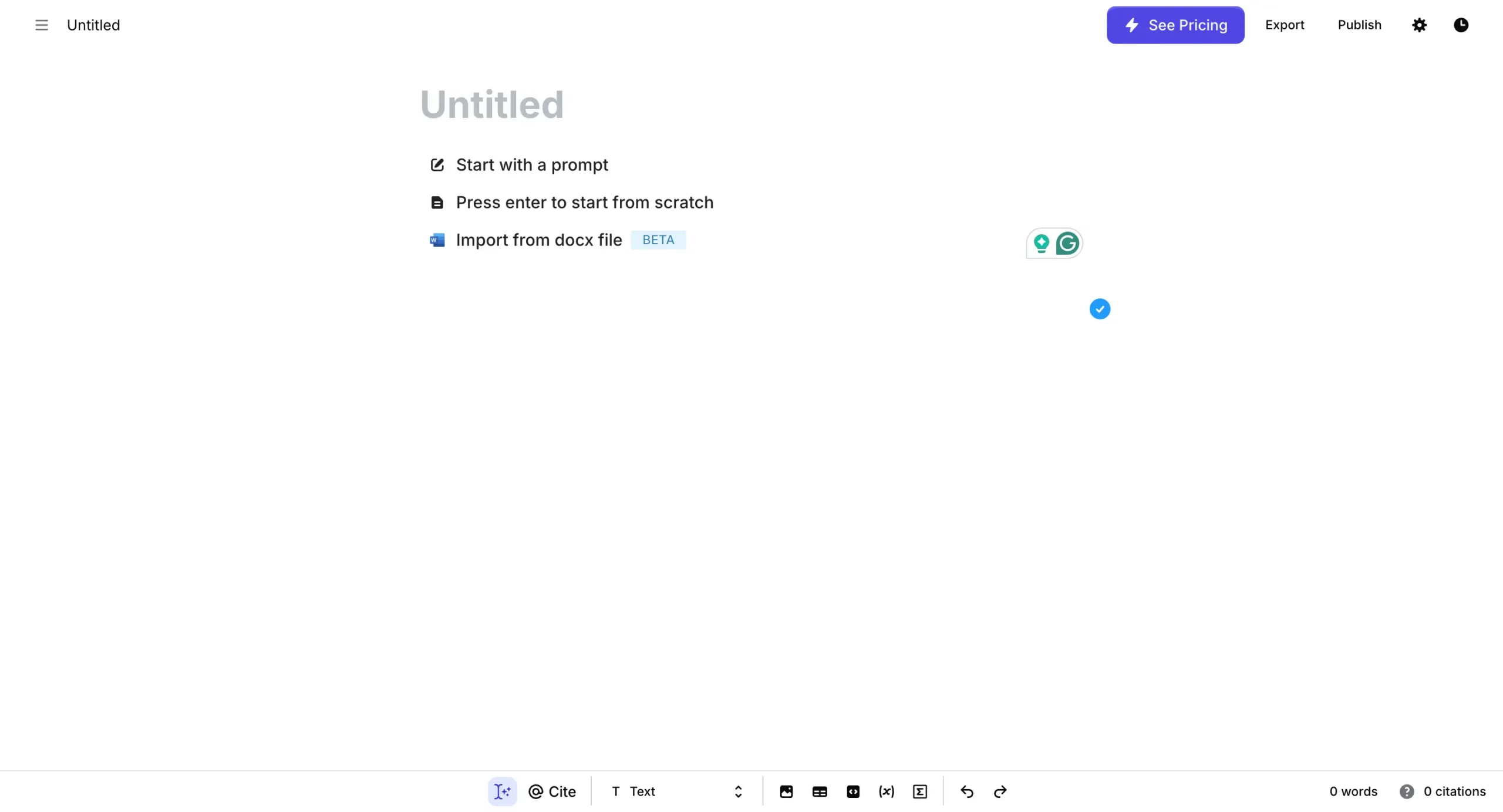
It’s basically a blank document—the cleanest interface I’ve ever seen on any AI academic software—where you can start writing from scratch, import from a DOCX file, or use their “Start with a prompt” feature.

In the top right corner, click the settings icon to set preferences such as auto-complete, your preferred citation styles (with over 2,600 options available), font style, and more.
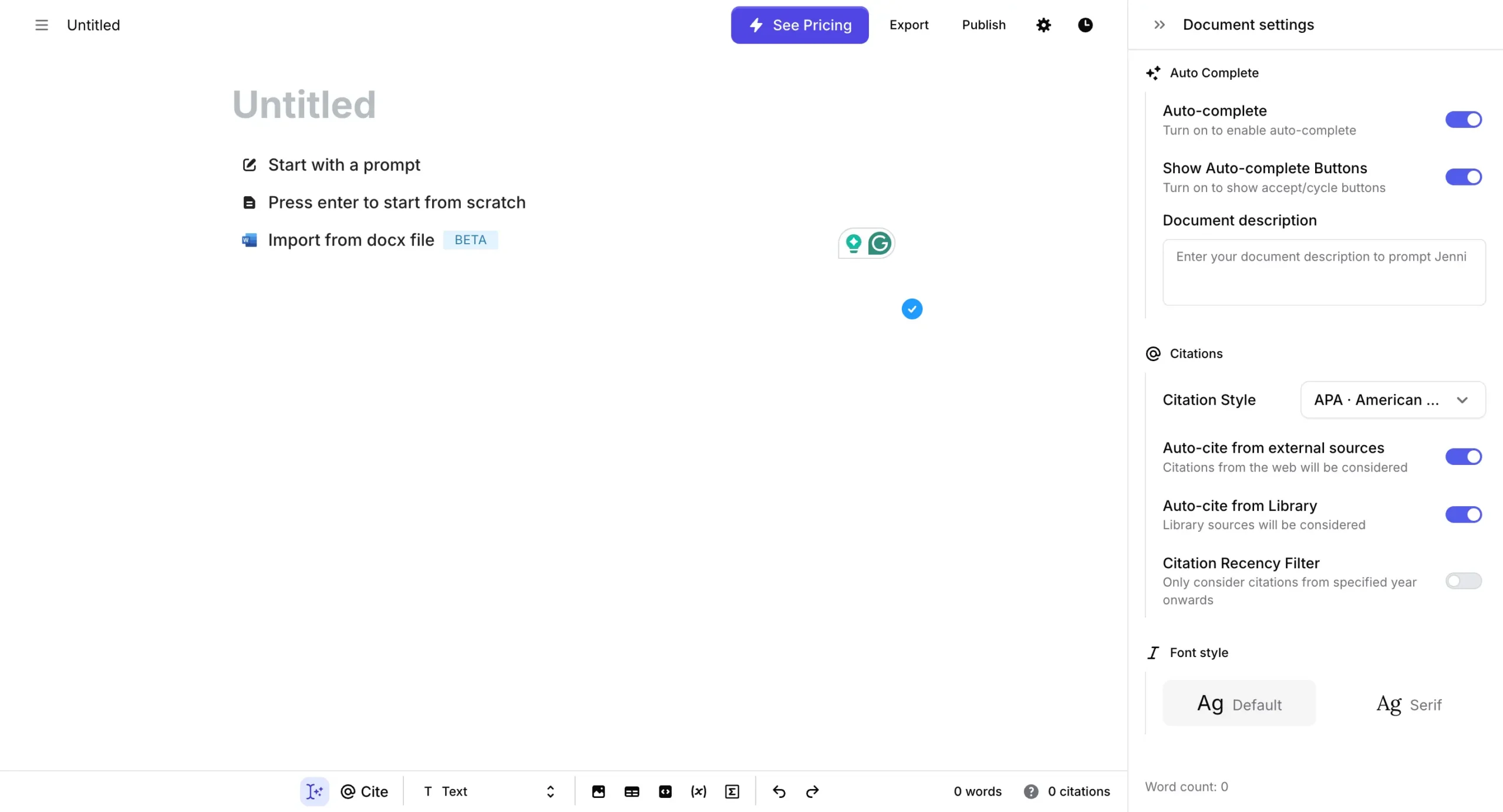
My favorite feature?
Auto-complete, for sure. When you finish writing a paragraph and hit space, Jenni AI suggests the next best paragraph.
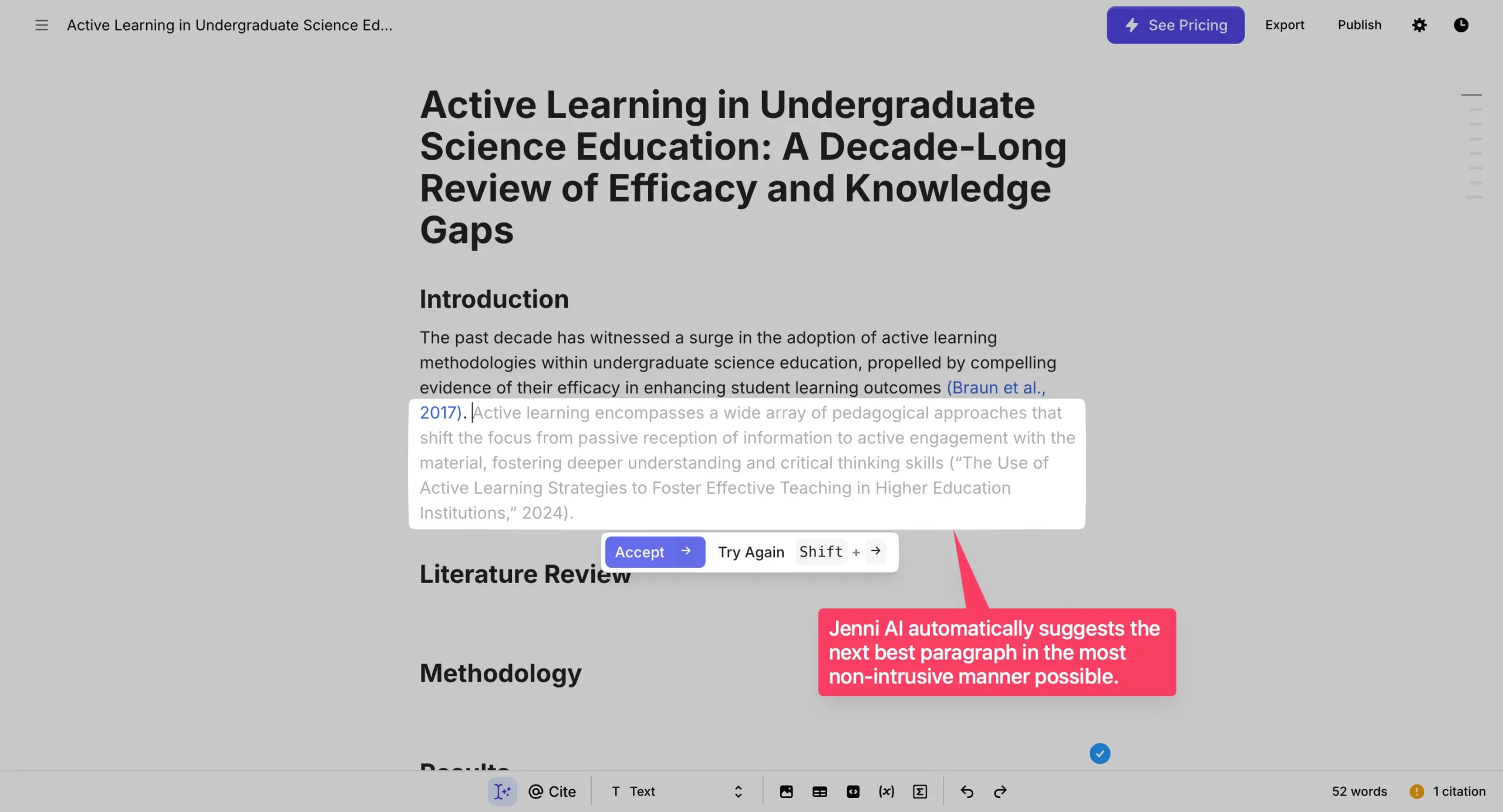
This is great because Jenni isn’t helping you write the whole paper at once (those are the worst). Instead, it’s helping you write yourself, think critically, and use AI when you genuinely need help.
The best part?
For almost every piece of content that Jenni generates, it automatically adds in-text citations along with the reference in your selected citation style.
You can export your writing document in LaTeX (.tex) and Word (.docx) formats.
SIDENOTE: The free plan allows partial document export, while the paid plan allows full document export.
Jenni AI pricing
Jenni offers the kind of pricing structure you wish every software company would adopt: Free ($0) or Unlimited ($12/month annually, $30 monthly).
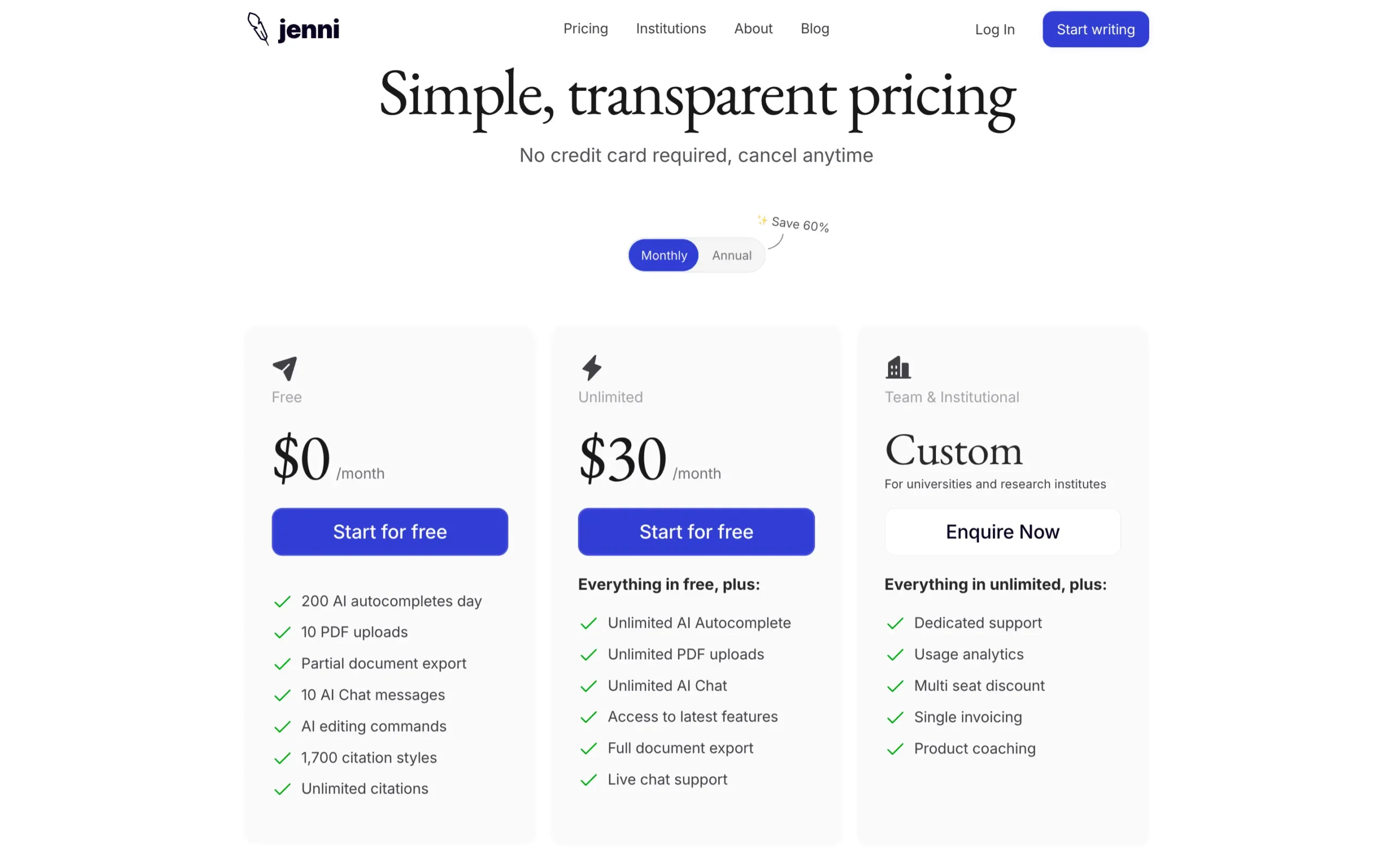
Just two clear options.
The free plan gives you 200 AI autocompletes daily and 10 PDF uploads monthly—enough to properly test the software before committing.
Jenni’s annual plan costs $144/year and includes everything—unlimited writing, PDF uploads, chat, and full document export.
#3 — Semantic Scholar
Available on: web.
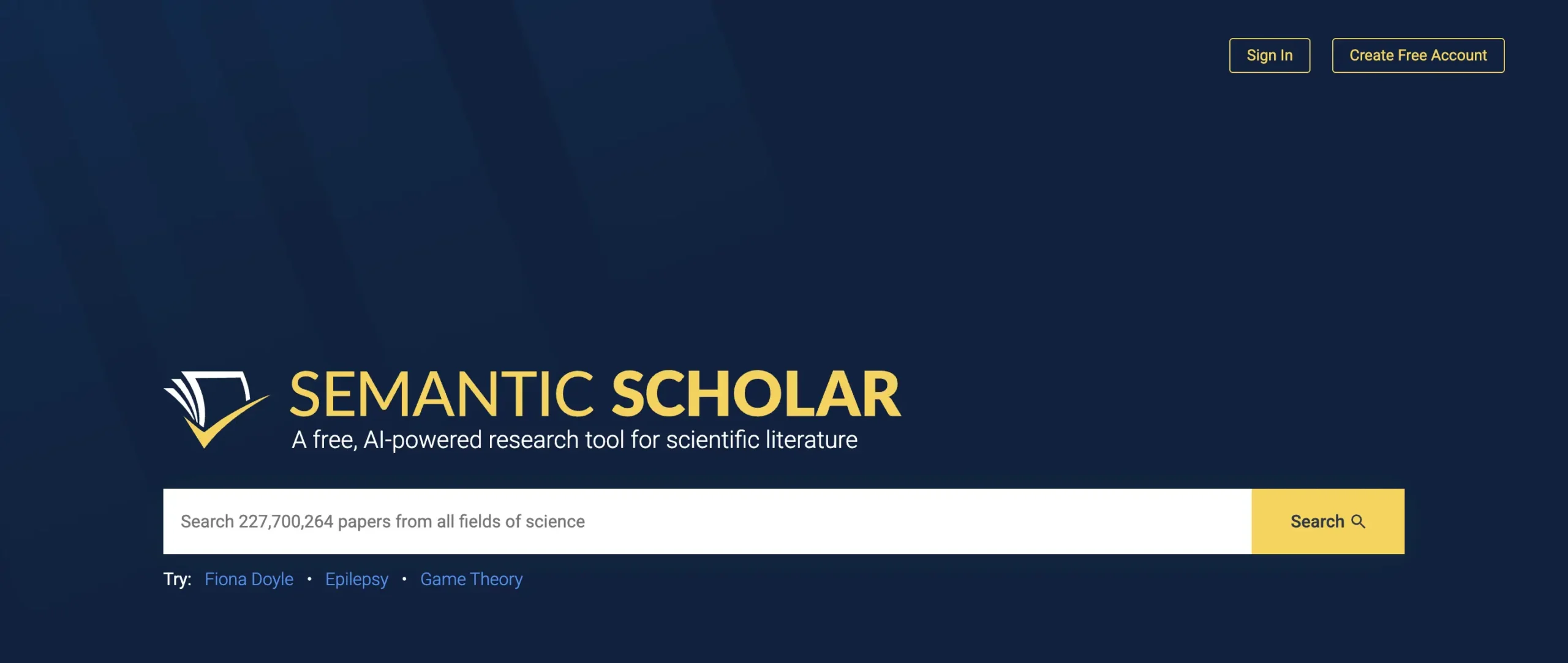
Semantic Scholar pros
Semantic Scholar cons
Semantic Scholar is a free AI-powered research discovery tool that helps you find and understand papers—nothing more, nothing less.
Semantic Scholar doesn’t try to write your paper. It doesn’t check your grammar. It doesn’t even let you highlight text.
What it does is solve one actual problem researchers have: getting lost in papers.
The killer feature? TLDRs.
TLDRs (Too Long; Didn’t Read) are super-short summaries of the main objective and results of a scientific paper, generated using expert background knowledge and the latest NLP techniques.
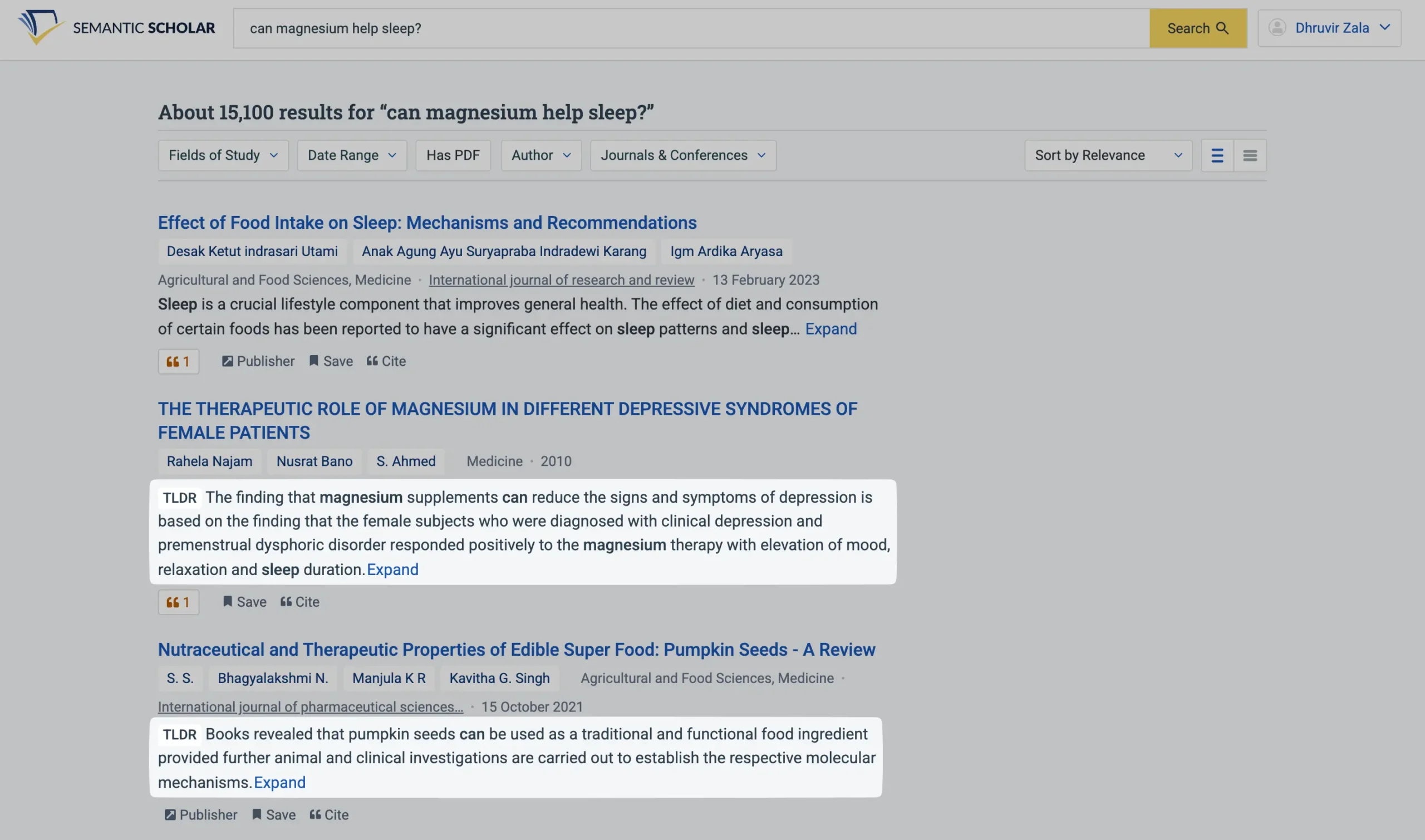
“Since TLDRs are 20 words instead of 200, they are much faster to skim”, explains Daniel S. Weld, General Manager at Semantic Scholar.
This changes everything: Instead of scrolling through 200-word abstracts written in academic-ese, you see 20-word summaries and abstracts that actually tell you what each paper does.
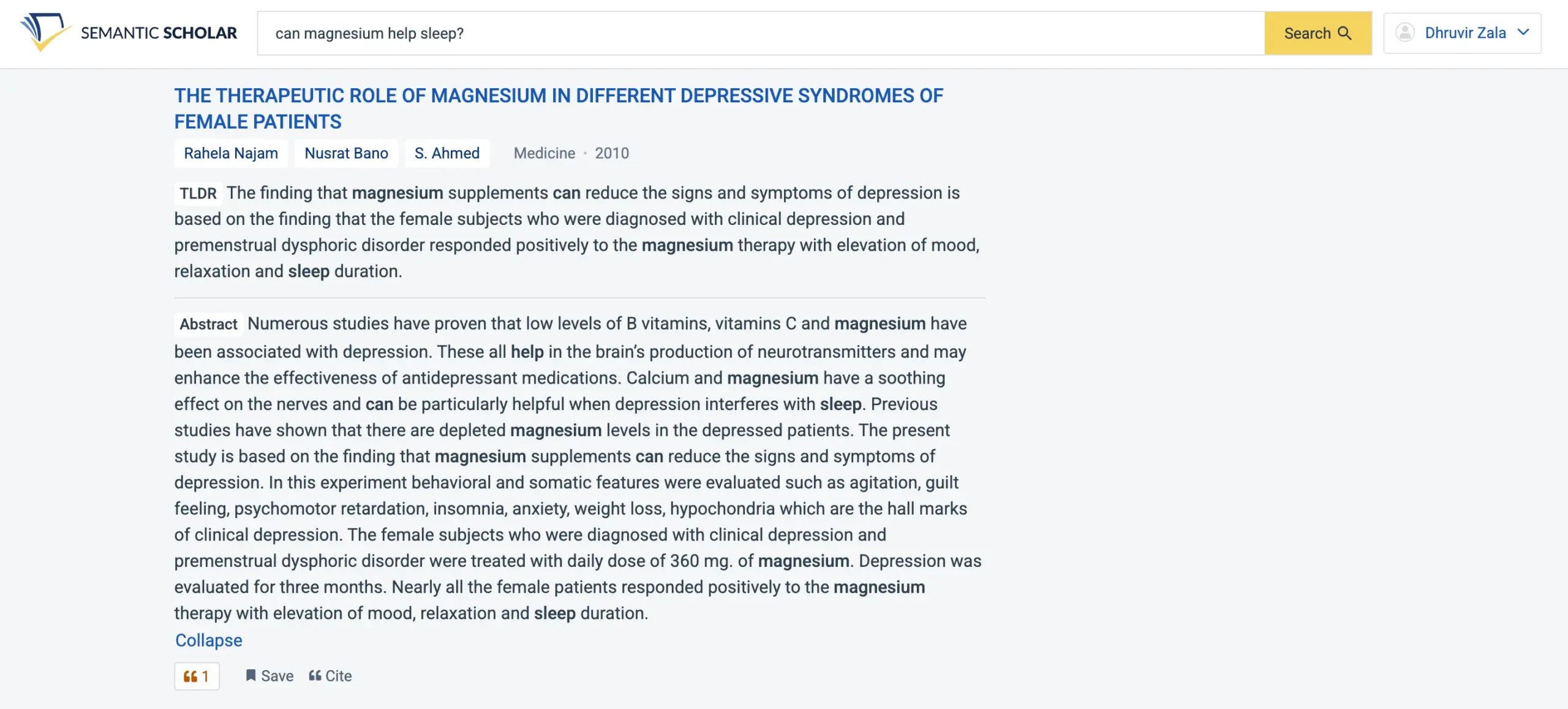
But the real magic happens with Research Feeds.
Once you add papers to your library, Semantic Scholar picks up on your interests and recommends relevant new research.
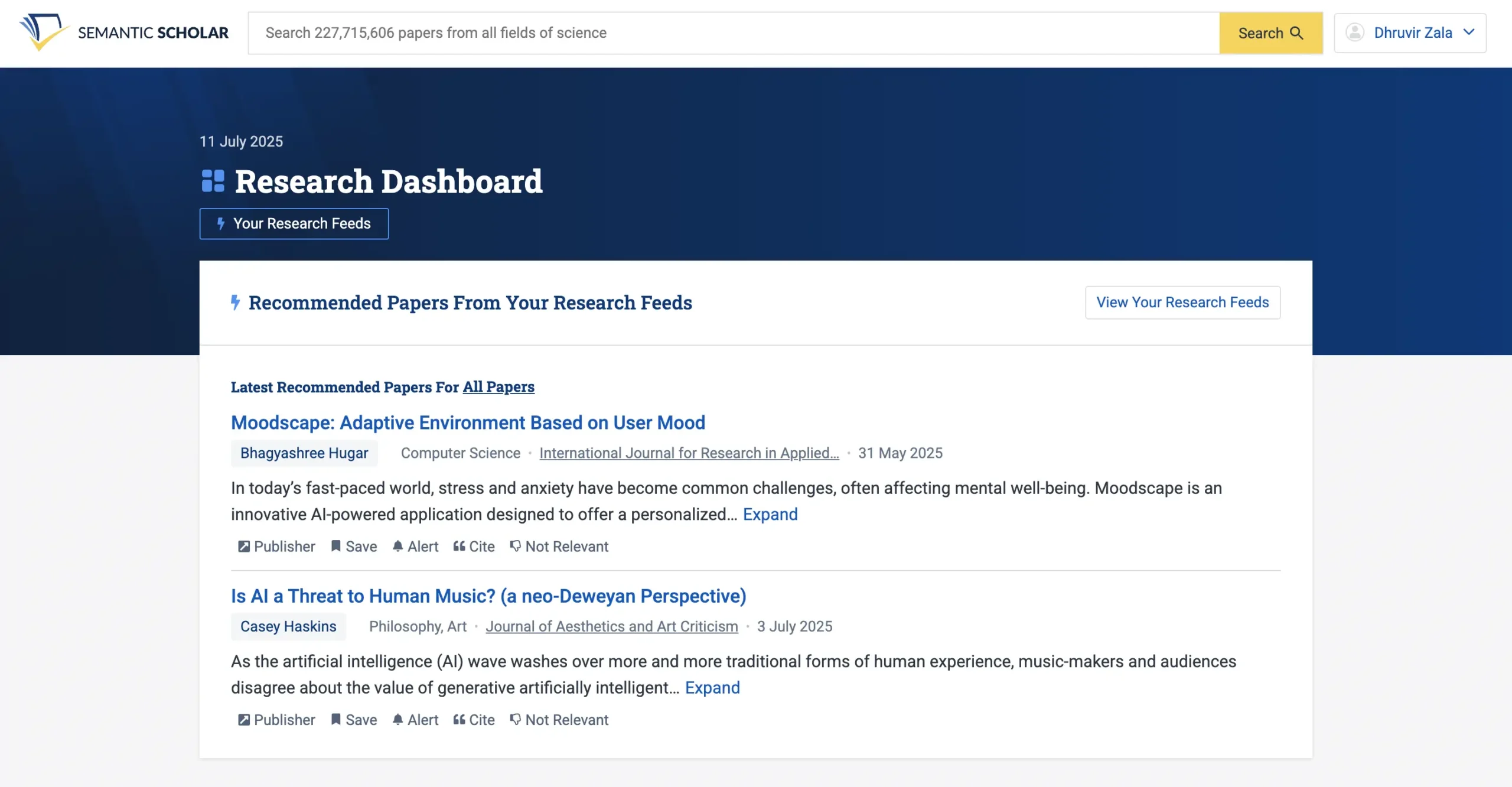
Here’s how researchers actually use it:
1. Start with a search: Type anything—author names, paper titles, DOIs, or broad topics. The AI understands context, not just keywords.

2. Skim TLDRs: Available for nearly 60 million papers in computer science and biomedicine. Skip the papers that don’t matter.
3. Check influence: See which citations actually matter with “Highly Influential Citations”—the AI identifies papers that meaningfully build on the work.
4. Build your library: Save relevant papers. The AI learns from every addition.
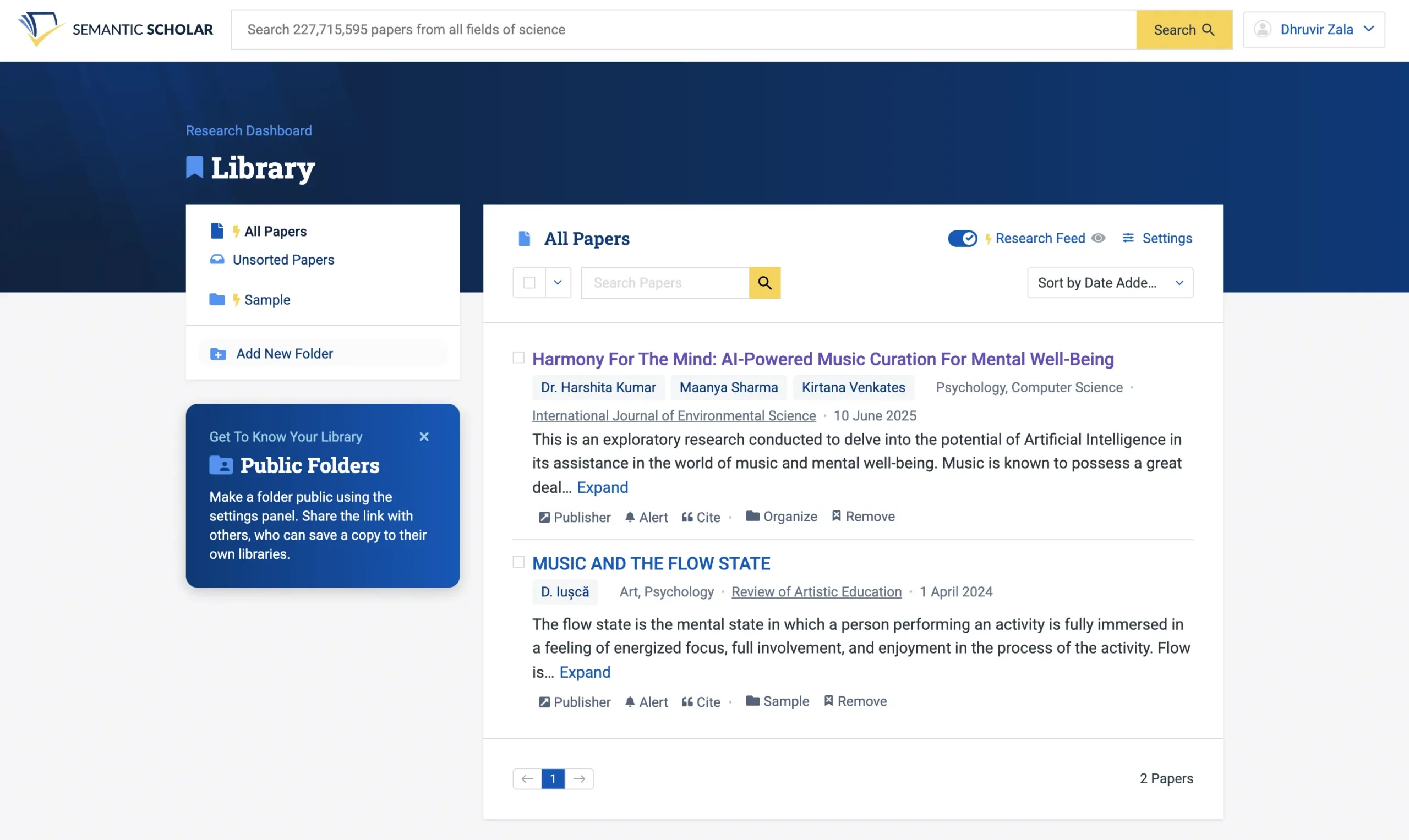
5. Let it feed you: Research Feed Alerts send new papers based on your Research Feed ratings straight to your inbox.

But here’s what Semantic Scholar doesn’t do: write anything.
No AI writer. No paraphrasing tool. No grammar checker. No plagiarism detection.
If you need those features (and let’s be honest, you probably do), Semantic Scholar won’t replace SciSpace. It’s a complement, not a replacement.
Semantic Scholar is free to use and unlike similar search engines (i.e. Google Scholar) does not search for material that is behind a paywall.
By staying focused on discovery rather than creation, they’ve built something sustainable without charging users.
Semantic Scholar pricing
There isn’t any.
Semantic Scholar provides free, AI-driven search and discovery tools and open resources for the global research community.
#4 — Elicit
Available on: web, Chrome extension.
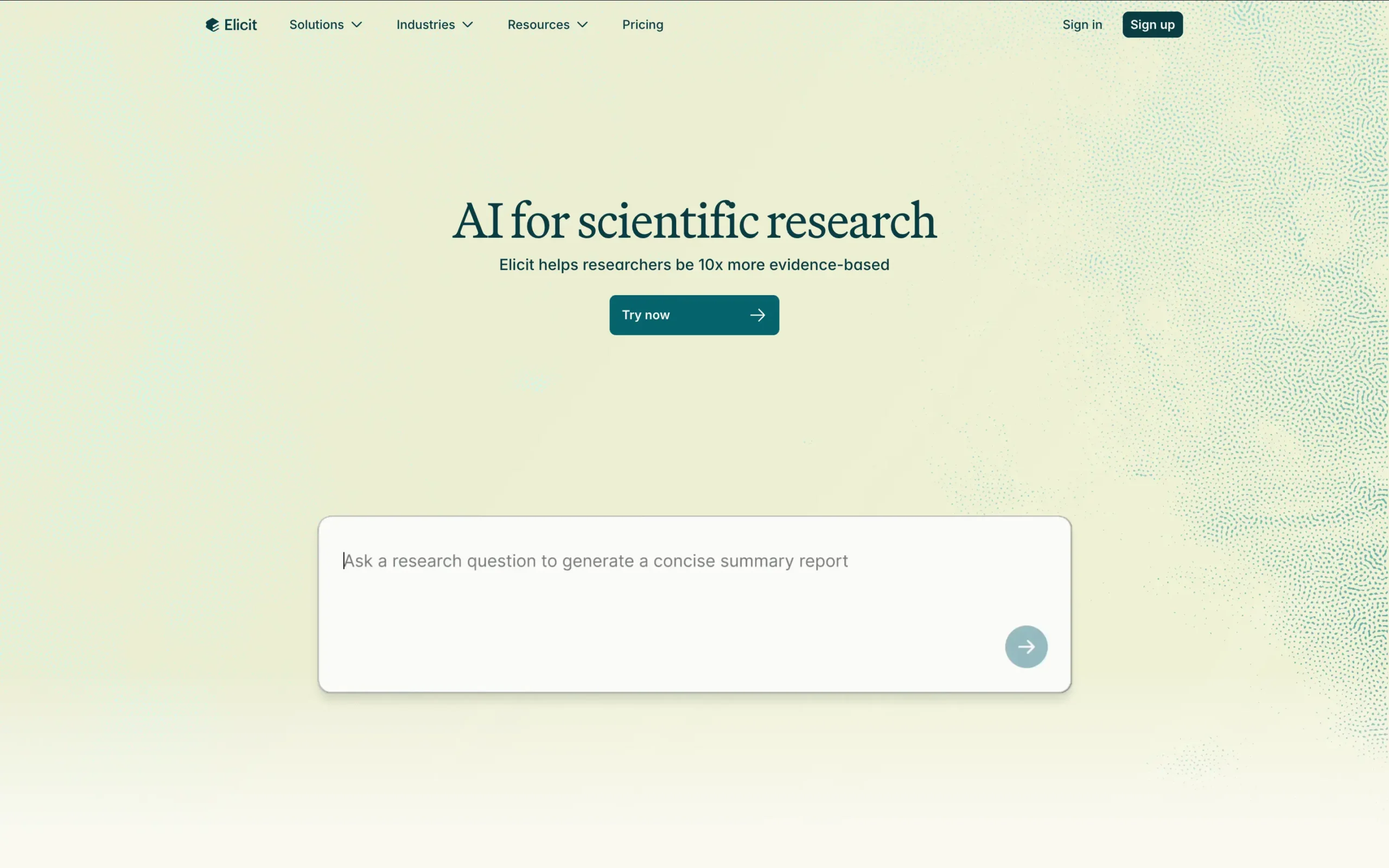
Elicit pros
Elicit cons
Elicit is your AI research assistant, and at first glance, it looks like SciSpace with better design sense.
You get the same core features: search through 125 million research papers, generate literature reviews, upload and extract information from PDFs, and summarize academic concepts.
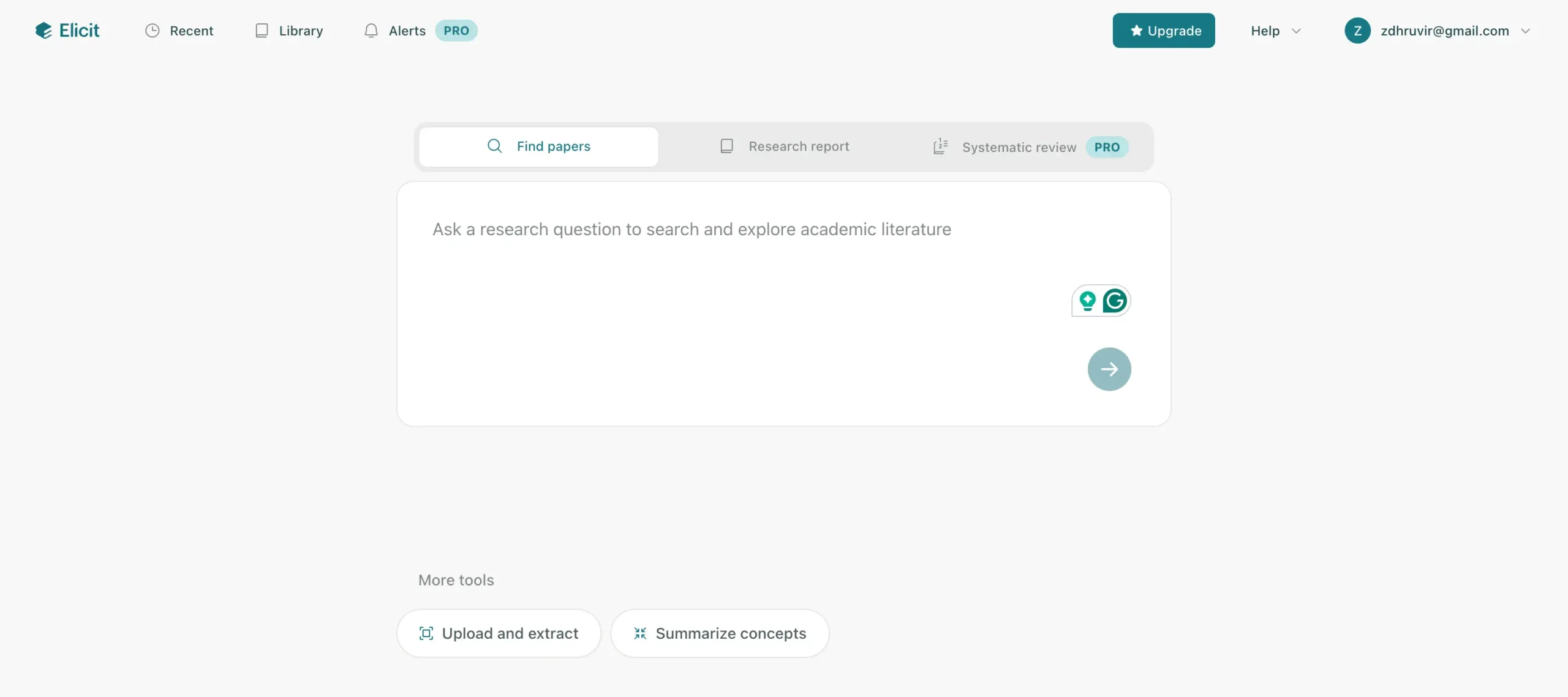
Like SciSpace’s Literature Review feature, Elicit offers “Research report” and “Systematic review” capabilities that generate structured research reports and extract data from papers.
You can upload papers, extract information, and summarize academic concepts just like you would in SciSpace.

But here’s where things get interesting.
While most tools solve interface problems by hiding complexity behind sidebars and menus, Elicit does the opposite.
They’ve managed to fit every important feature into a single screen without creating visual chaos.
If Jenni AI wins for cleanest writing interface, Elicit wins for cleanest research interface.
The literature review feature works almost identically to SciSpace’s. Enter any academic topic, and you get a summary of the top 4 papers (or 8 with paid plans).

Below that summary sits the dynamic table—essentially SciSpace’s best feature, reimplemented.
You get the same filterable interface with default columns for Paper and Abstract summary, plus the ability to add AI-powered columns like main findings, methodology, and limitations.

But then Elicit does something clever. Below the table, there’s a feature called “Add a new step.”
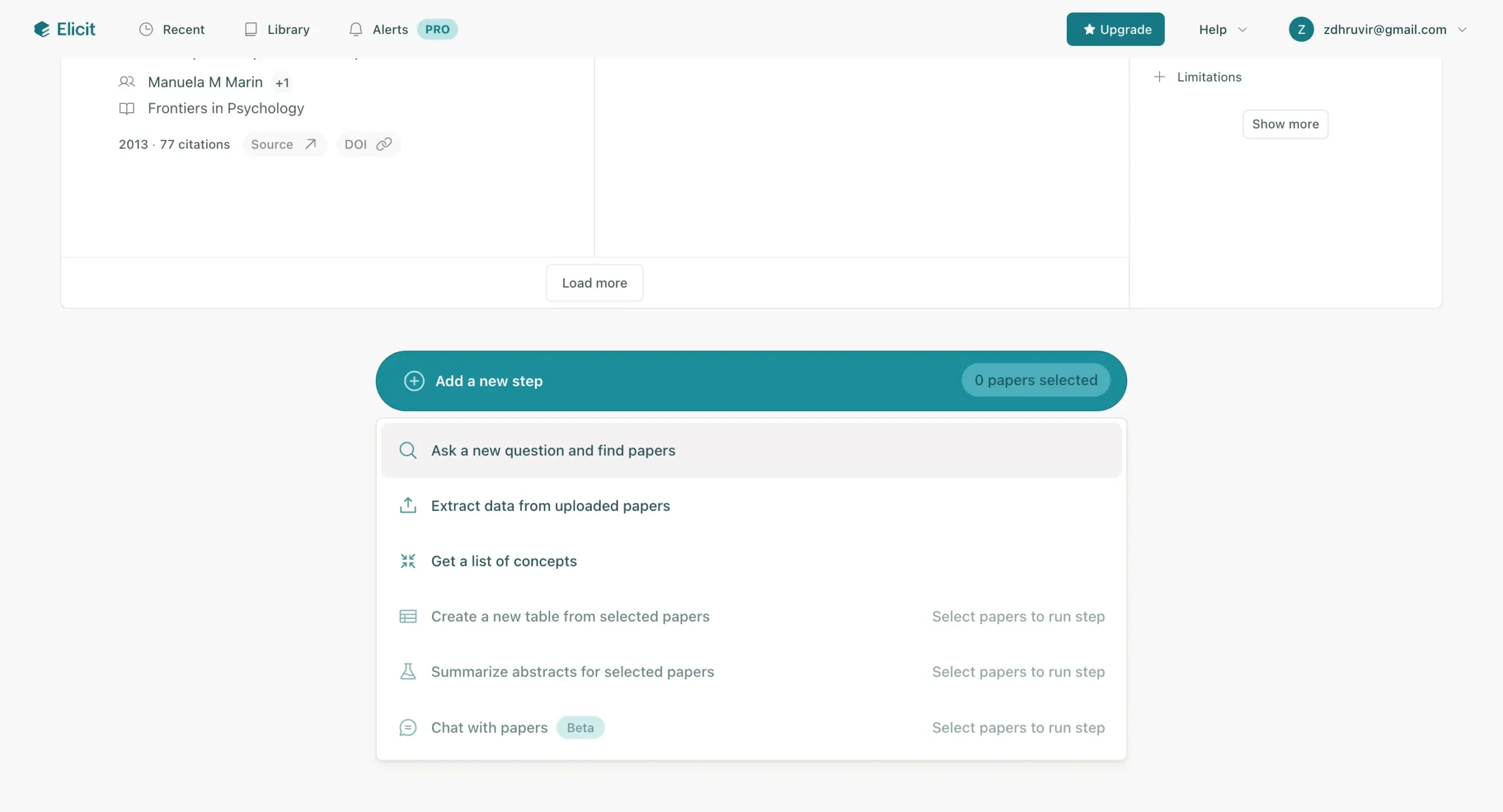
You select papers from the table and perform the next logical action: create a new table from selected papers, summarize abstracts for those papers, or chat with them directly.
This workflow approach is smarter than it first appears. Instead of forcing you to start fresh each time, Elicit lets you build on previous work.
Research isn’t linear, so why should research tools pretend it is?
You can read papers directly in Elicit’s clean PDF reader, though, like most alternatives, it lacks basic features like highlighting and annotations.
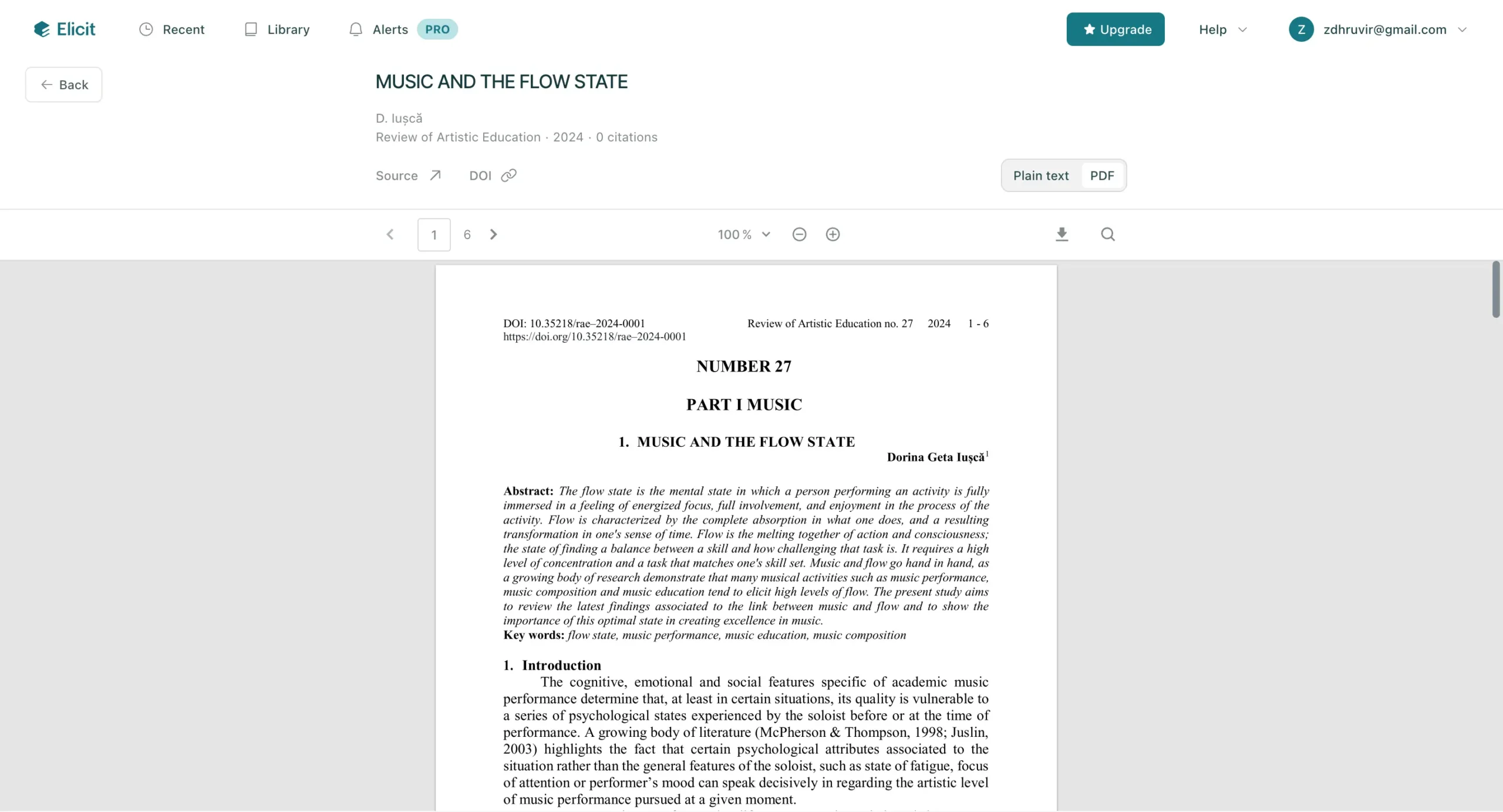
Elicit connects with Zotero, importing papers from your existing collections—a crucial feature that many competitors ignore.

What’s missing?
The same things that are missing from Semantic Scholar: no plagiarism detection, no AI writing features, no grammar checking.
Elicit works best as a SciSpace alternative if you want the same core research capabilities but prefer a cleaner design and potentially better customer support.
Their free plan is more generous than most competitors, including SciSpace.
Elicit pricing
Elicit offers five tiers:
- Basic (Free)
- Plus ($10/month annually, $12 monthly)
- Pro ($42/month annually, $49 monthly)
- Team ($65/member annually, $79 monthly)
- And Enterprise (custom pricing).
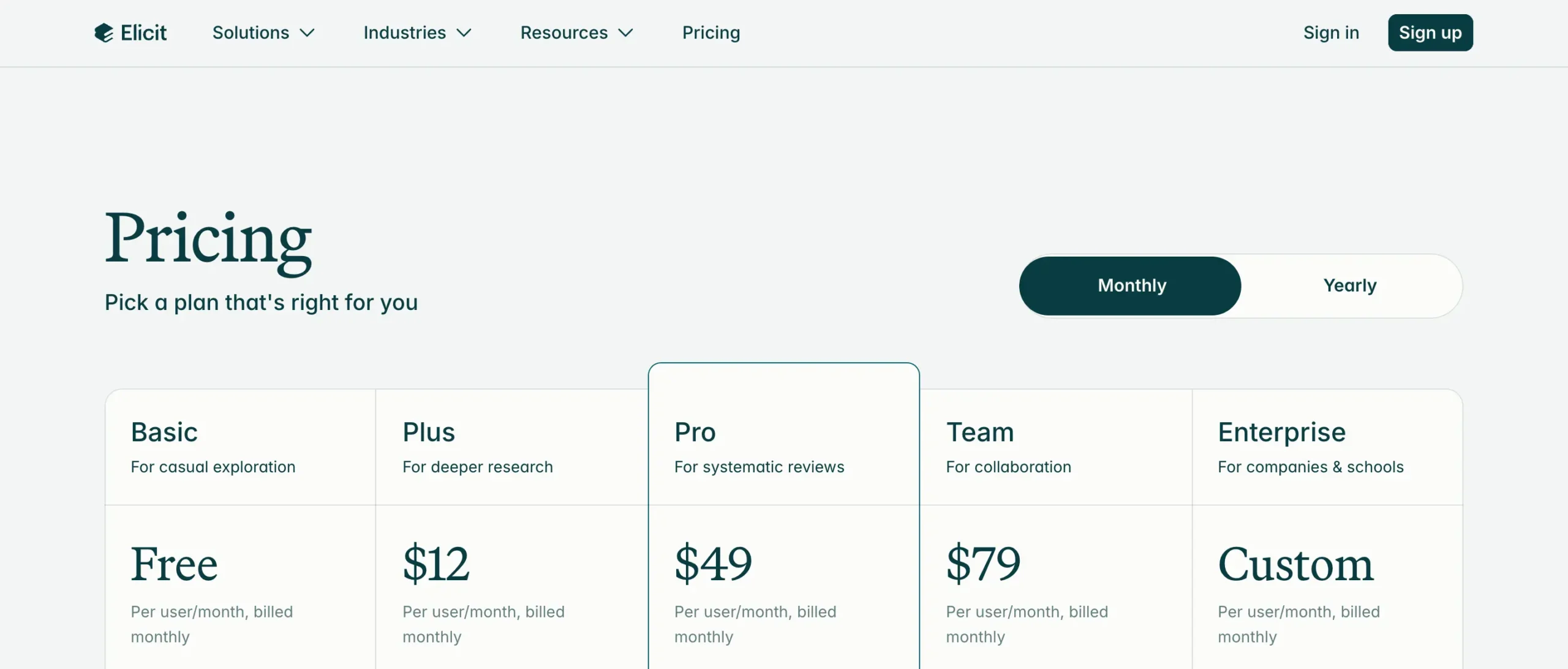
The free plan is surprisingly generous—unlimited search across 125+ million papers, unlimited summaries of 4 papers at once, unlimited chat with 4 papers, extract data from 20 papers monthly, and Zotero import.
Here’s what matters for the SciSpace comparison:
Elicit’s Plus plan ($120/year) gives you everything most researchers need—unlimited chat with 8 papers, extract data from 600 papers yearly, and 5 custom table columns.
For most researchers, escaping SciSpace, Elicit’s Plus plan delivers better value at half the annual cost.
#5 — Consensus
Available on: web.

Consensus pros
Consensus cons
Consensus is an AI-powered search engine that helps you find the most relevant scientific research papers from over 200 million papers and counting.
Consensus feels different from the start.
Unlike most competitors, which require you to sign up before using their features, Consensus offers practically zero time-to-value. You can test its scientific search engine before even signing in.
From their about page:
“We’re building the best way to search, synthesize, and understand scientific knowledge—so researchers can get back to science, not searches, and everyone can access evidence, not opinion.”
Consensus’s interface is as clean as Elicit’s, if not cleaner.

You have a collapsible left sidebar with all features in a single interface.
Speaking of features, Consensus doesn’t have many—roughly the same number as Semantic Scholar.
However, this laser focus is precisely what enables them to build a truly great and reliable academic research engine, backed by $11.5 million in Series A funding.
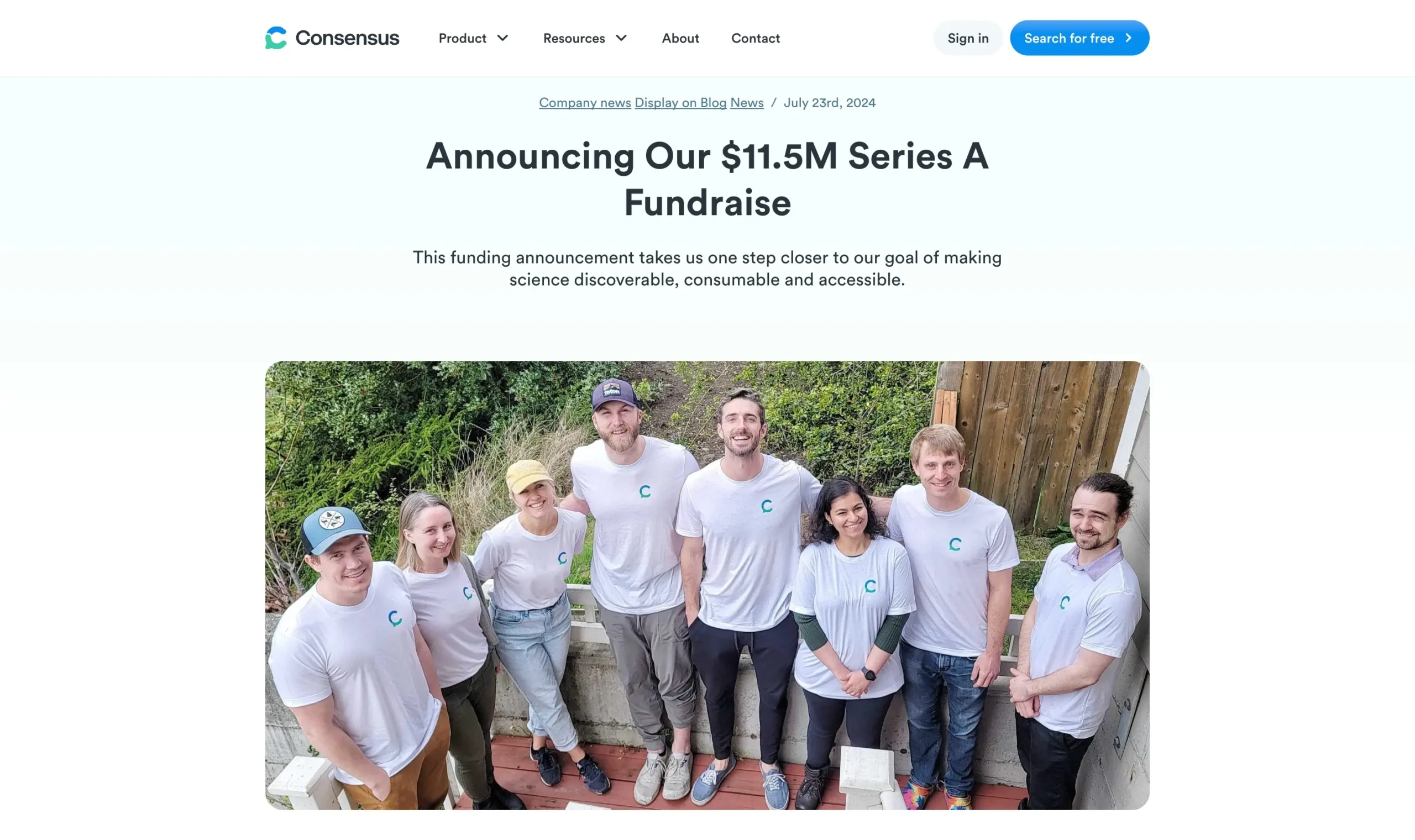
Back to the dashboard: Consensus offers one core feature—the search engine. Enter your research question, select the search mode, apply output filters if needed, and hit enter.
Consensus offers three search modes:
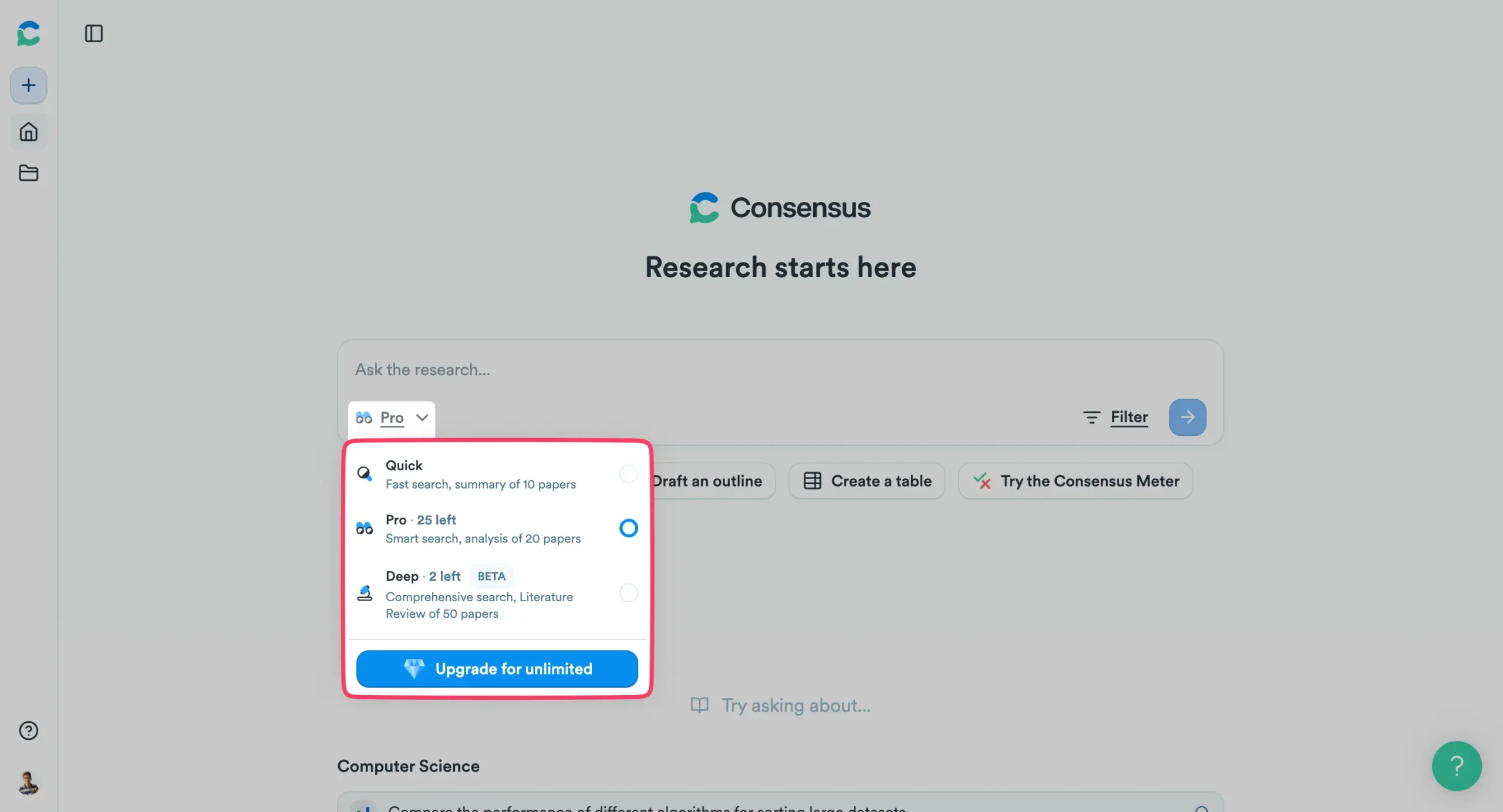
- Quick: Fast search, summary of 10 papers.
- Pro: Smart search, analysis of 20 papers.
- Deep: Comprehensive search, literature review of 50 papers.
These modes compare to SciSpace’s Standard, High Quality, and Deep Review search options.
Let’s examine the output quality. I’ll search “can magnesium help sleep?” using “Deep” mode with no filters.
The right sidebar shows Consensus’s “Deep” mode doing its research. This can take time as it searches through and filters thousands of papers.
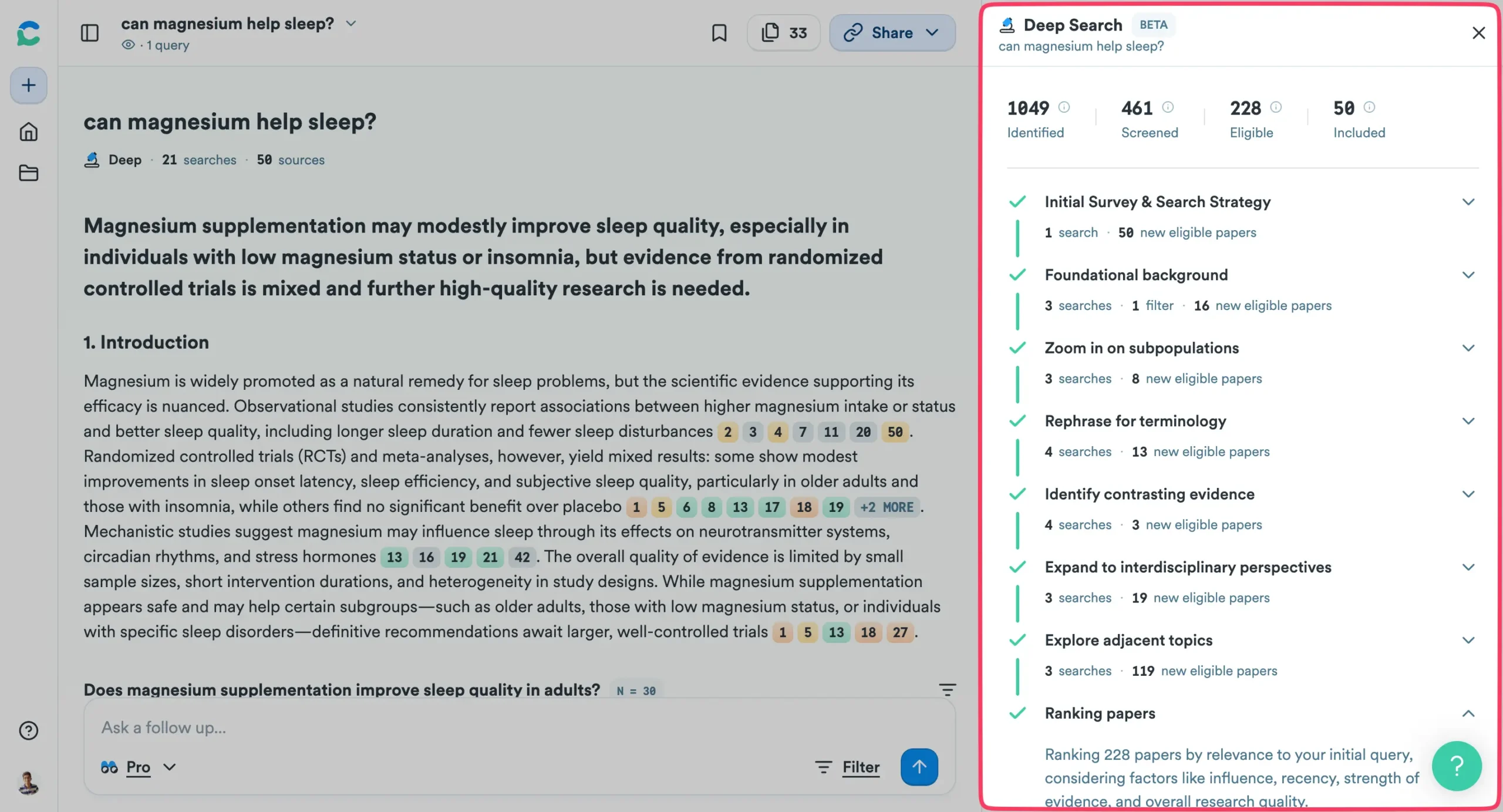
For my “can magnesium help sleep?” query, Consensus’s “Deep” mode identified 1,049 papers, screened 461, marked 228 as eligible, and included 50 in the final output.
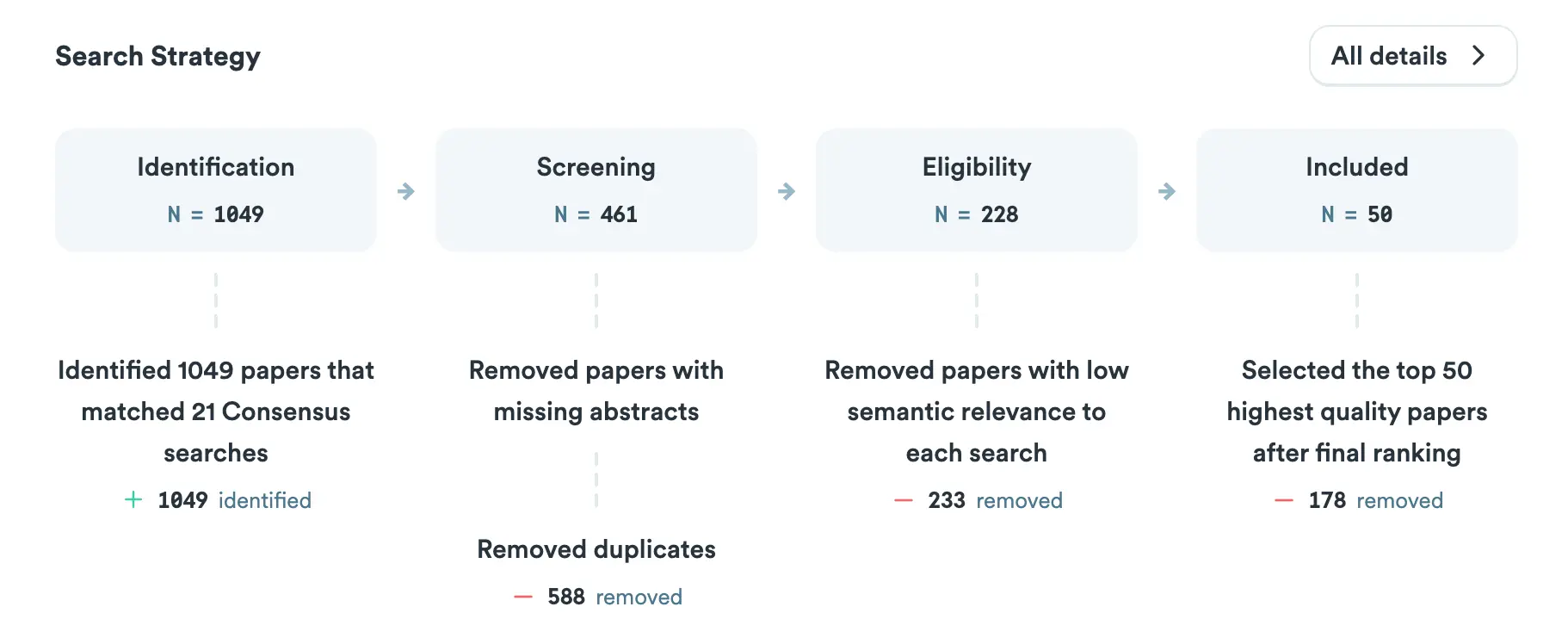
Impressive—the best I’ve seen so far.
The detailed output starts with a conclusive statement and introduction.
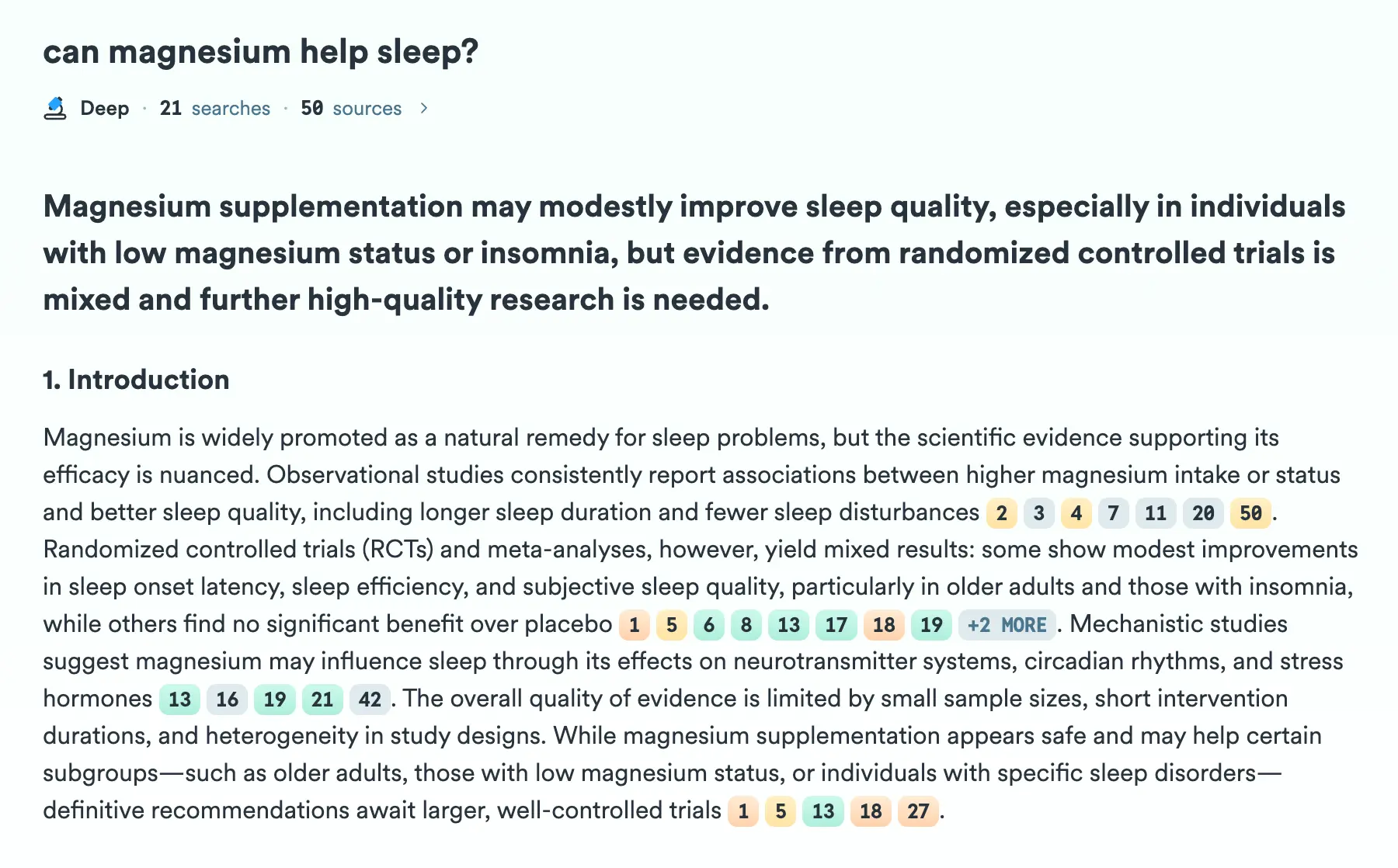
Next comes the Consensus Meter, a proprietary feature that shows the collective sentiment of research papers on your specific query.
For my question, 37% of research papers say yes to “can magnesium help sleep?”, 13% say no, and so on.
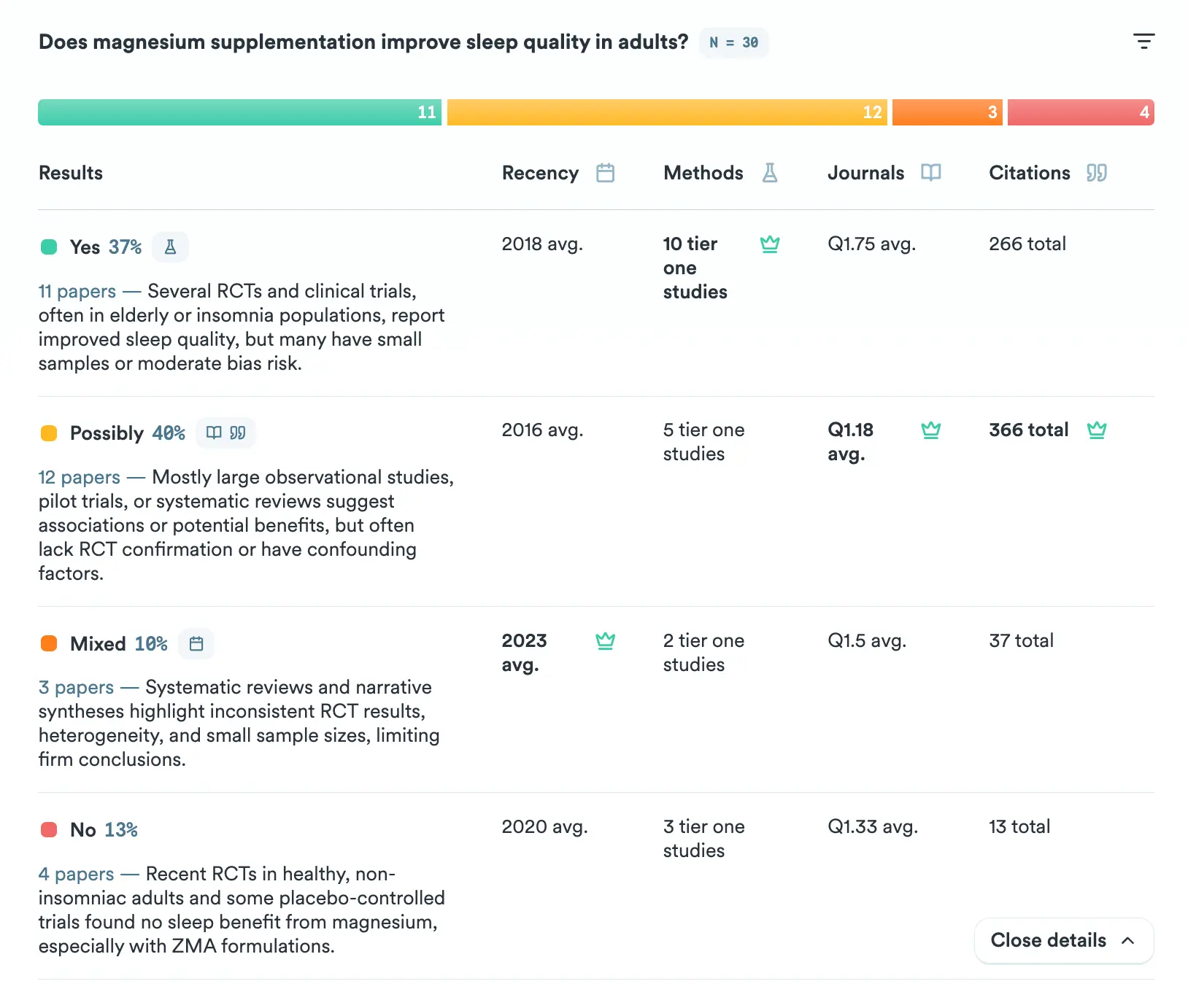
Below the Consensus Meter, you get detailed explanations covering Methods, Results, Discussion, Conclusion, follow-up questions, and all sources.
Click any source to open it directly within Consensus and learn more.
Consensus doesn’t mess around when it comes to delivering exactly what you’re looking for.
While it only handles academic search and literature reviews, the output quality is exceptional.
Highly recommended!
Consensus pricing
Consensus follows the same two-tier simplicity as Jenni: Free ($0) or Premium ($8.99/month annually, $11.99 monthly).
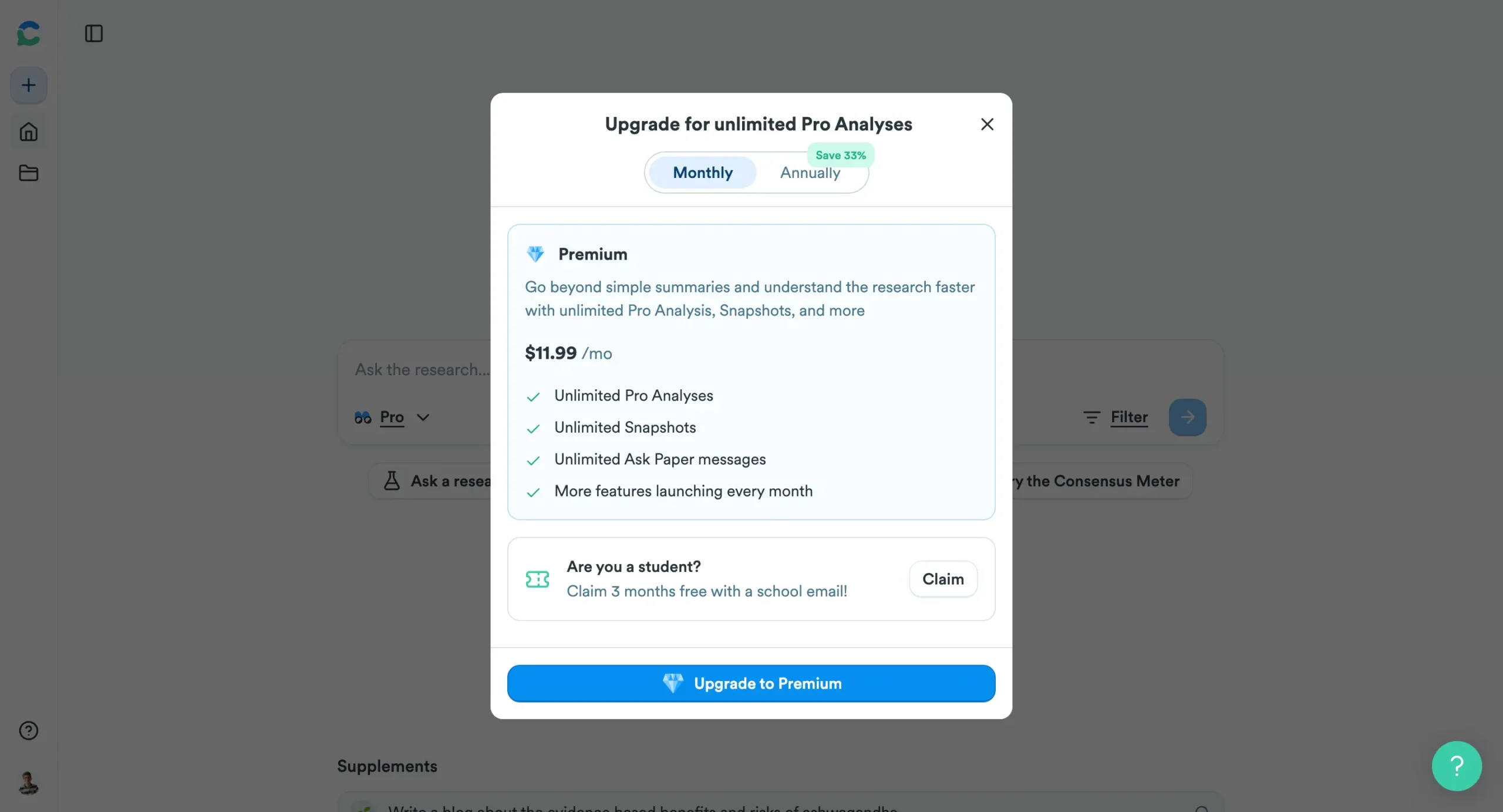
The free plan is generous, offering 10 Pro Analyses per month, unlimited searches across 200+ million papers, and unlimited bookmarks.
For teams, Consensus offers volume discounts starting at $9.99 per seat annually, which is significantly cheaper than SciSpace’s institution-focused Advanced plan.
The honorable mentions (for specific needs)
1. Scite — If you need to verify citation credibility. Shows whether papers support or contradict cited claims.

Scite has indexed over 1.3 billion citations and uses Smart Citations to show whether articles support, contrast, or simply mention a given claim.
Most academics treat citations like votes. Big number = good paper. But what if half those citations are saying you’re wrong?
At $20/month ($12/month when billed yearly), it’s academic truth serum.
2. Research Rabbit — If you’re a visual learner who needs to see research connections mapped out.
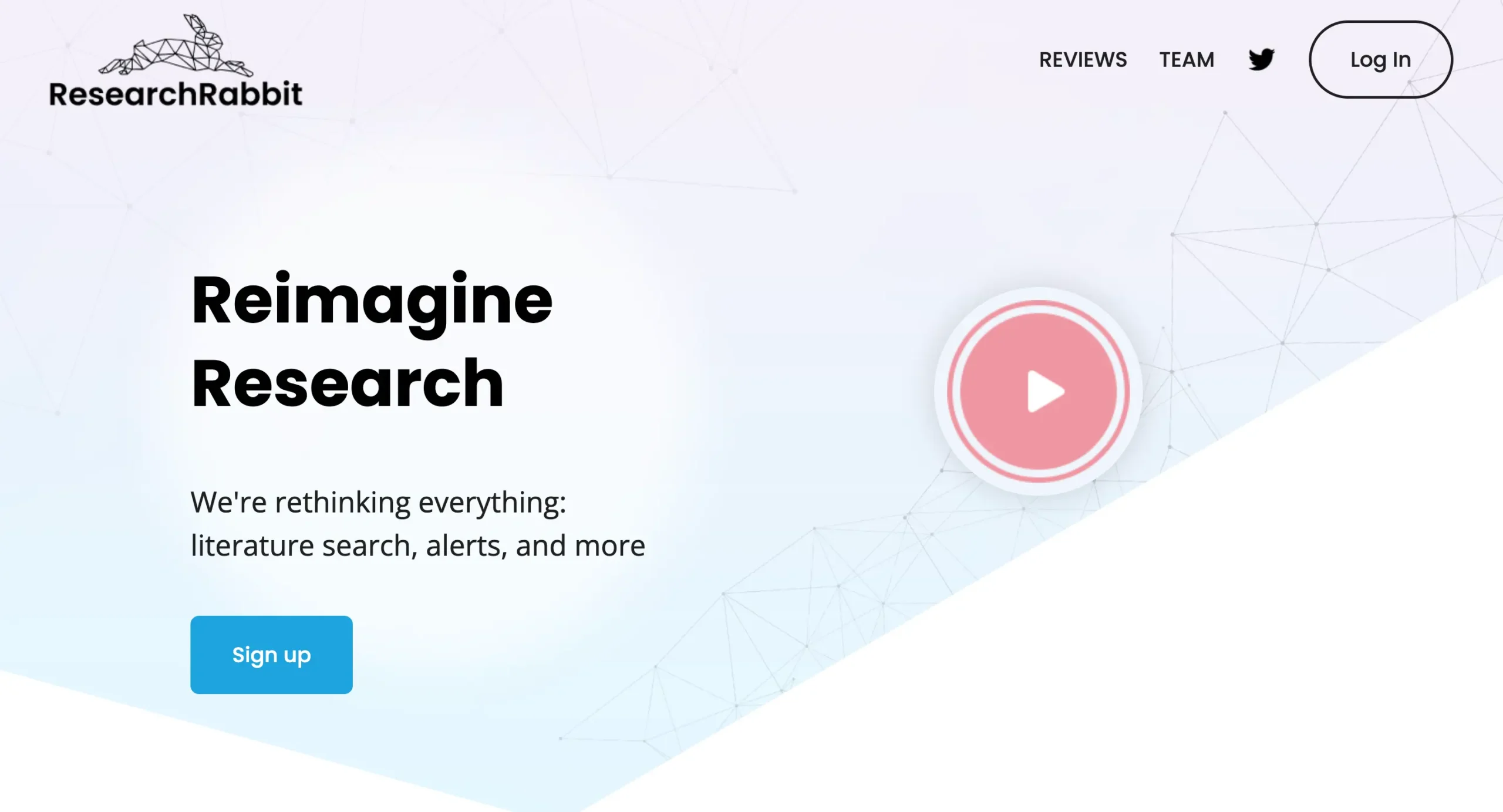
You start with one paper, and it generates recommendations through visualization maps that reveal connections between publications you’d never spot otherwise.
It turns literature review into visual exploration. Completely free forever.
The catch?
Their database stopped updating in 2021, so you’re exploring a three-year-old snapshot of research.
Which tool will actually save your research?
The best research tools disappear while you use them.
Paperpal if you write papers.
Elicit if you loved SciSpace’s tables but hated everything else.
Semantic Scholar if you just need to find papers.
Jenni AI if you want a writing companion with you all the time.
Consensus if you need scientific consensus, not cherry-picked studies.
But honestly?
90% of you just need Paperpal. The other tools are for edge cases.
Paperpal handles the full academic workflow—reading, writing, citing, checking. One tool, one subscription, one less decision eating your mental bandwidth.
Pick one. Move on. Get back to research.
Disclosure: Our content is reader-supported. If you click on certain links we may make a commission.
Meet your guide
Dhruvir Zala
I help businesses and professionals stop wasting money on the wrong software. Most software reviews are just marketing in disguise. So I started writing the reviews I wish I had: thoroughly tested, brutally honest, and focused on what matters.
Wait — what’s actually slowing you down?
Most researchers waste money on tools that don’t match how they actually work. Pick your real bottleneck and I’ll show you the one that fixes it.
No thanks, I’ll keep juggling toolsYou need one tool that actually works
Most researchers use 3-5 tools because no single tool does everything. That’s expensive and annoying.
Paperpal is different. It handles the full workflow—reading papers, writing, citing, grammar checking, plagiarism detection. 22 years of academic publishing data backing it up.
Your discount: DZ30Copied! saves 30% on your first payment. That’s $41 back in your pocket.
AI shouldn’t write for you. It should help you write.
Most AI writing tools hijack your thinking. They write the whole paper and you edit it. That’s backwards.
Jenni AI works differently. It suggests the next paragraph when you’re stuck. Stays quiet when you’re not. You stay in control. Your thinking, better written.
Annual billing saves you 60%: Just $12/month instead of $30/month. That’s $216 saved per year.
SciSpace’s tables are good. Elicit’s are better.
You liked SciSpace’s dynamic tables. The problem was everything else—clunky interface, confusing workflows, mediocre support.
Elicit does the same thing but cleaner. Better design. Better workflow. Plus it connects with Zotero and costs half as much annually.
Elicit Plus is $120/year (or $10/month annually). That’s half what SciSpace charges for comparable features.
Stop citing cherry-picked studies
Most researchers find papers that support what they already think. That’s not research—it’s confirmation bias with footnotes.
Consensus searches 200M+ papers and shows you what % actually support each claim. It filters 1,000+ papers down to the 50 that matter. Real scientific consensus, not opinions.
Annual billing: Just $8.99/month ($108/year). Free plan includes 10 Pro analyses monthly to test it first.


